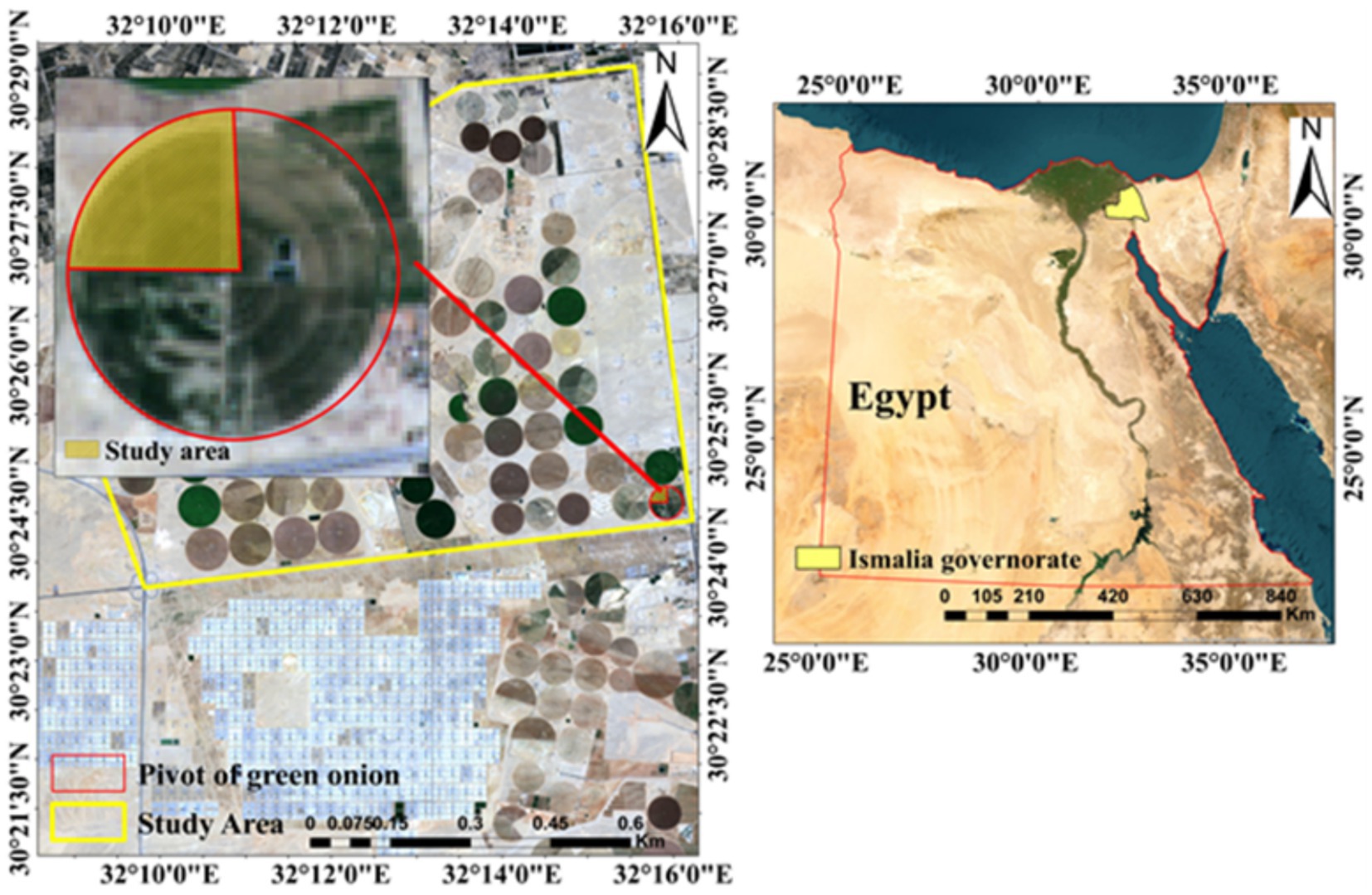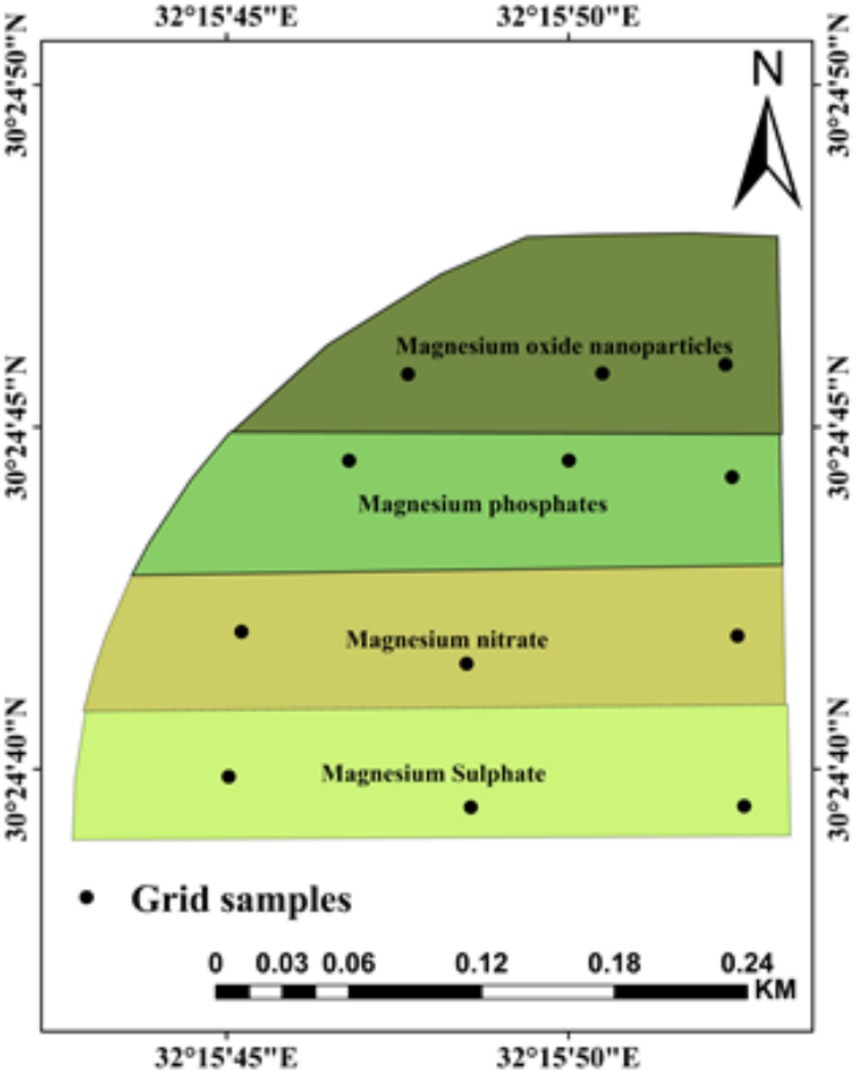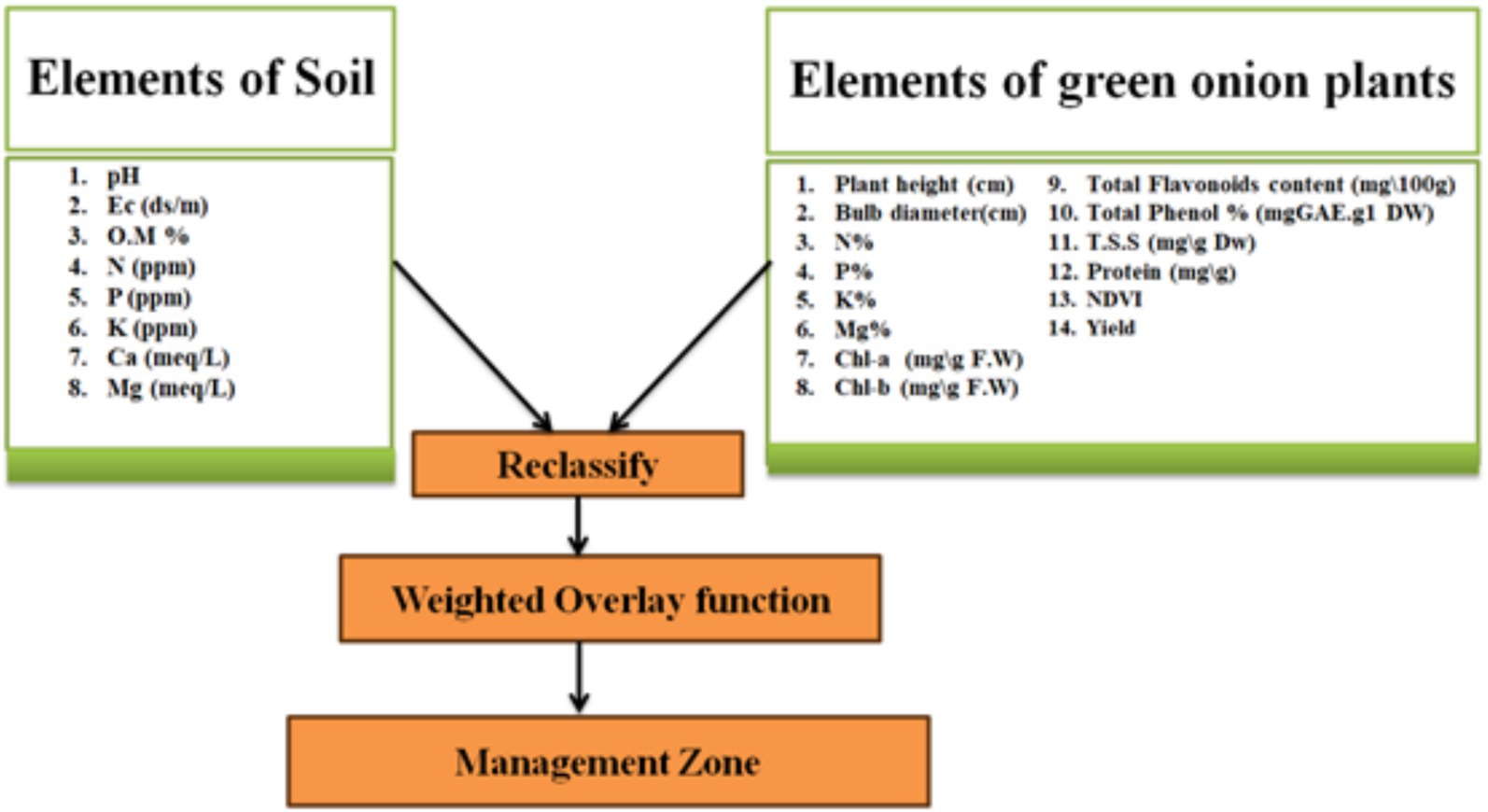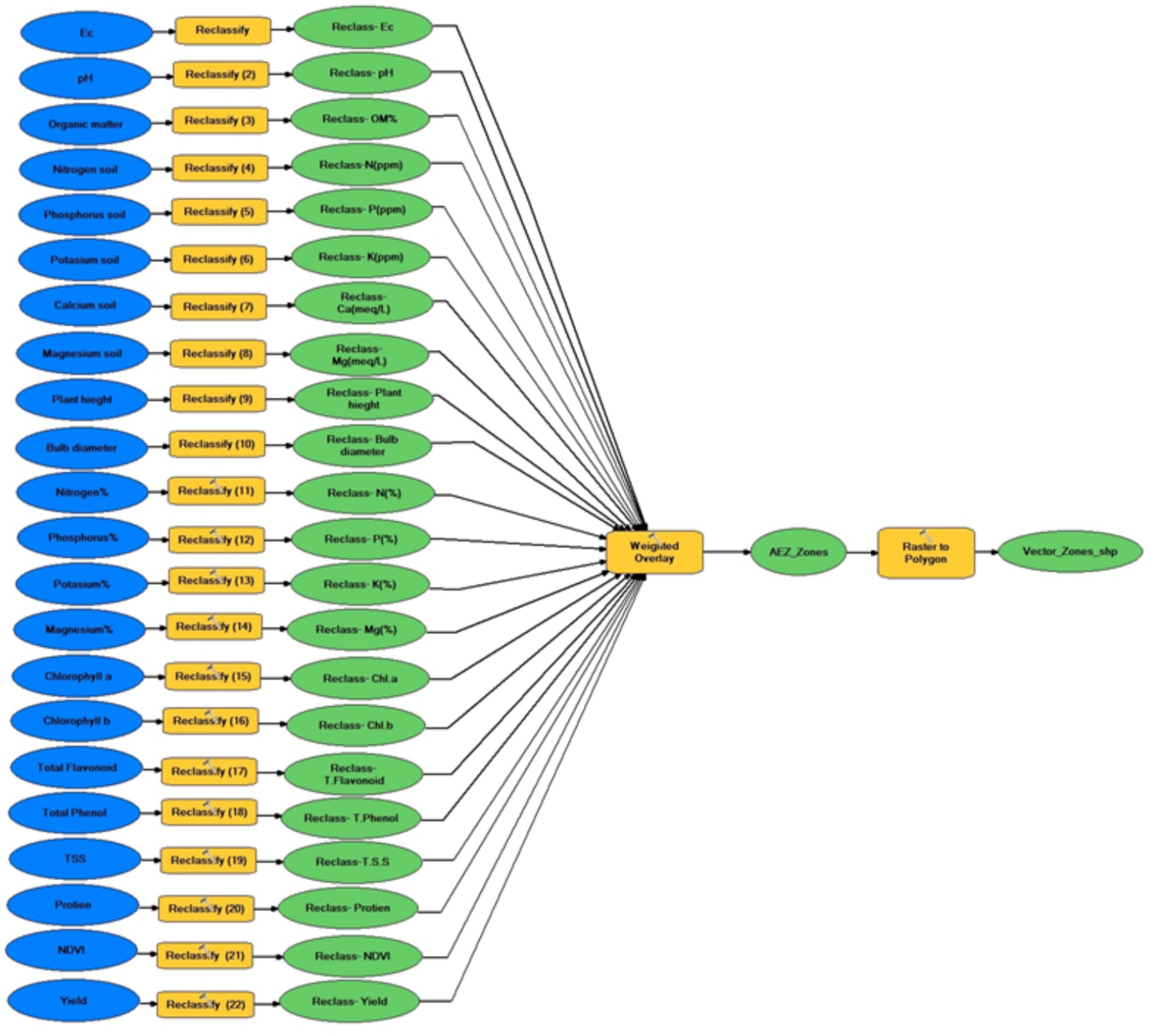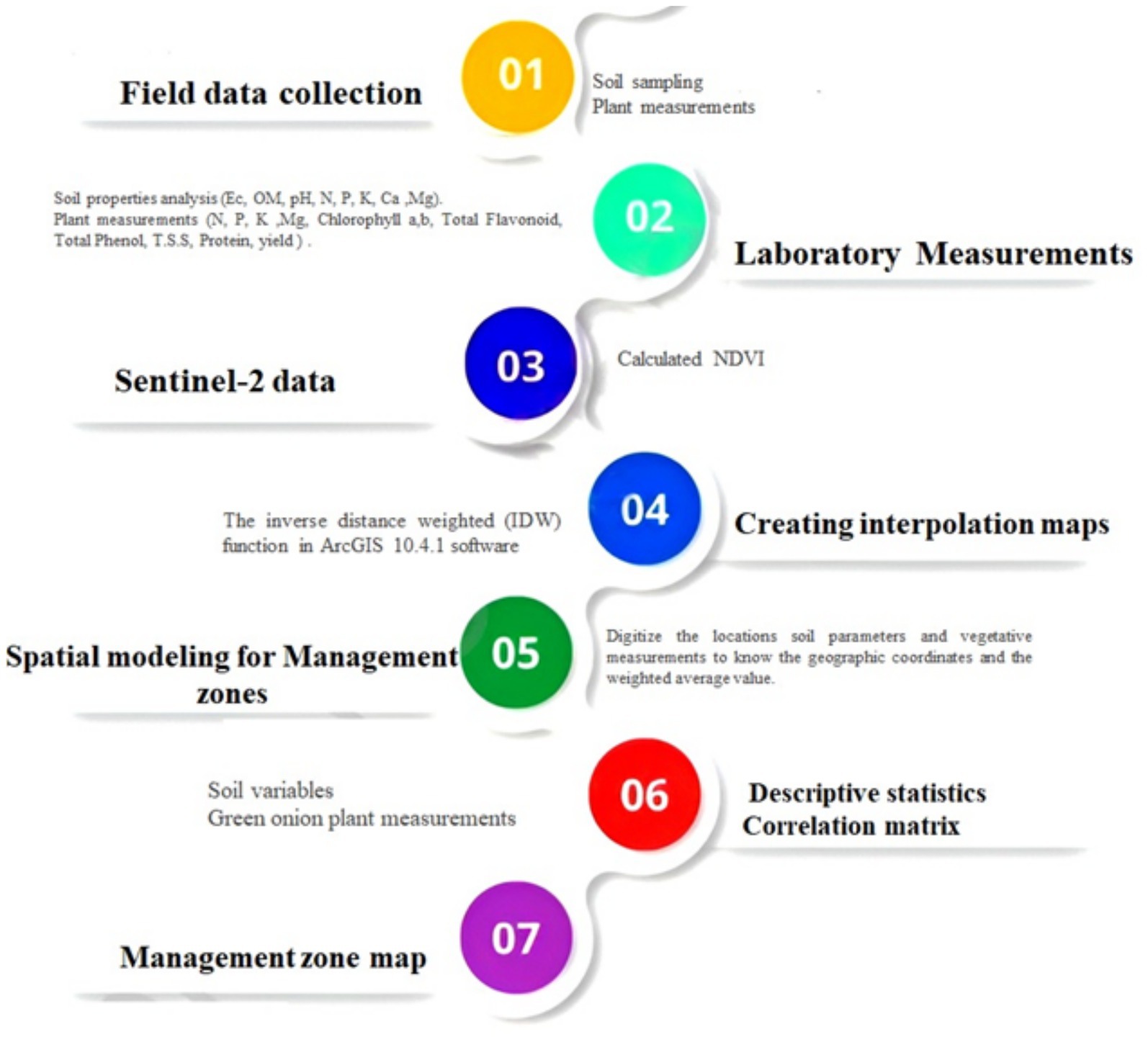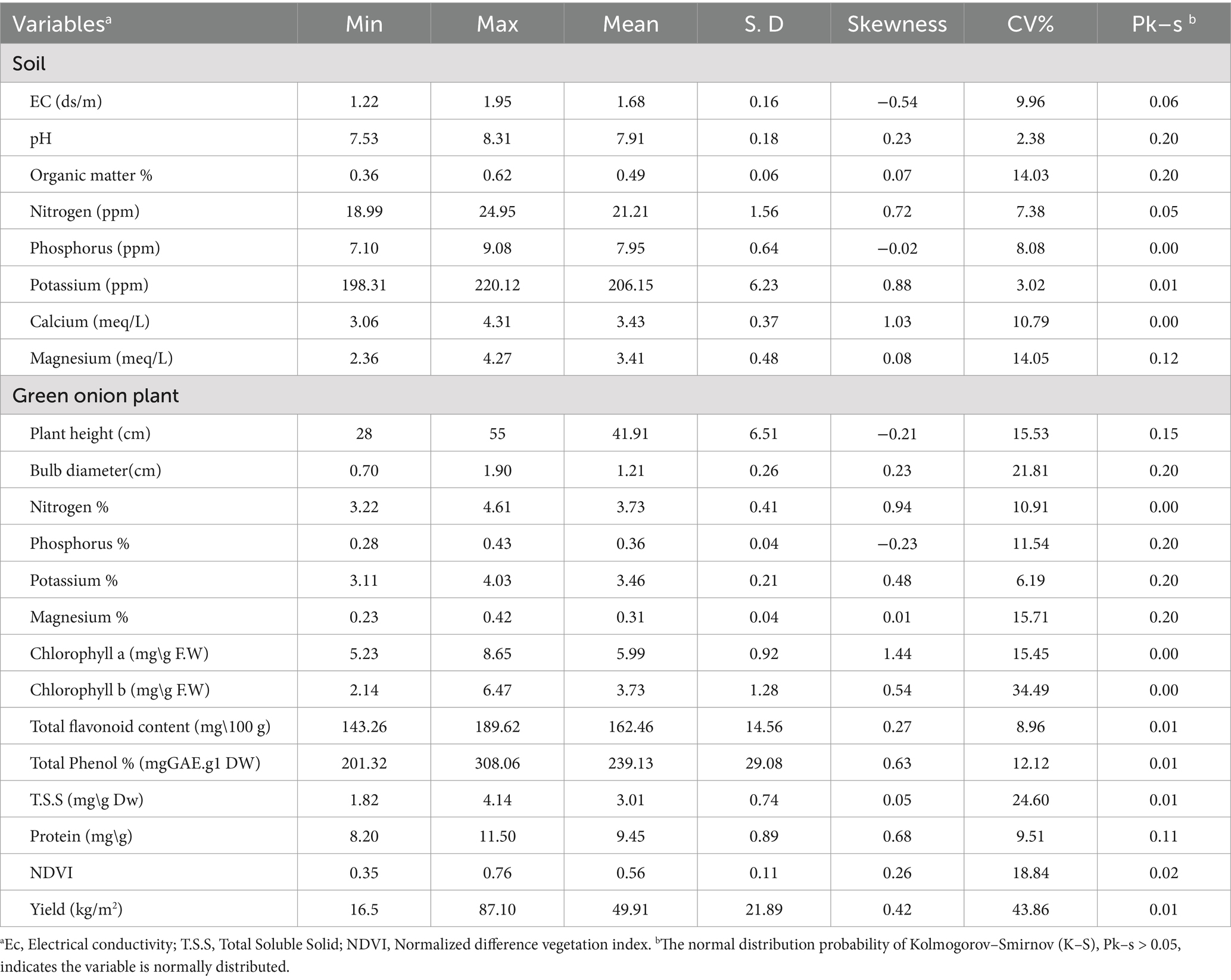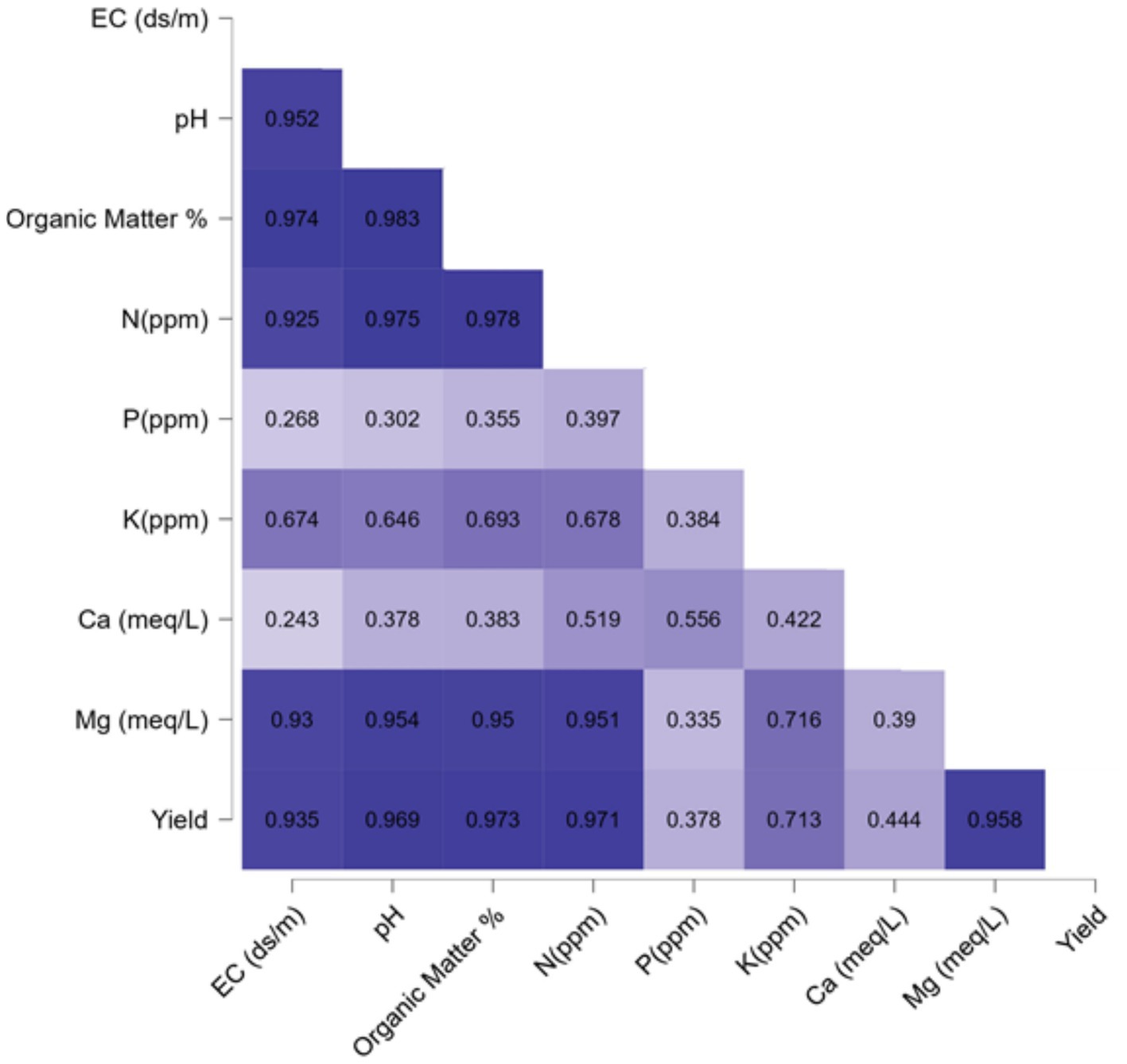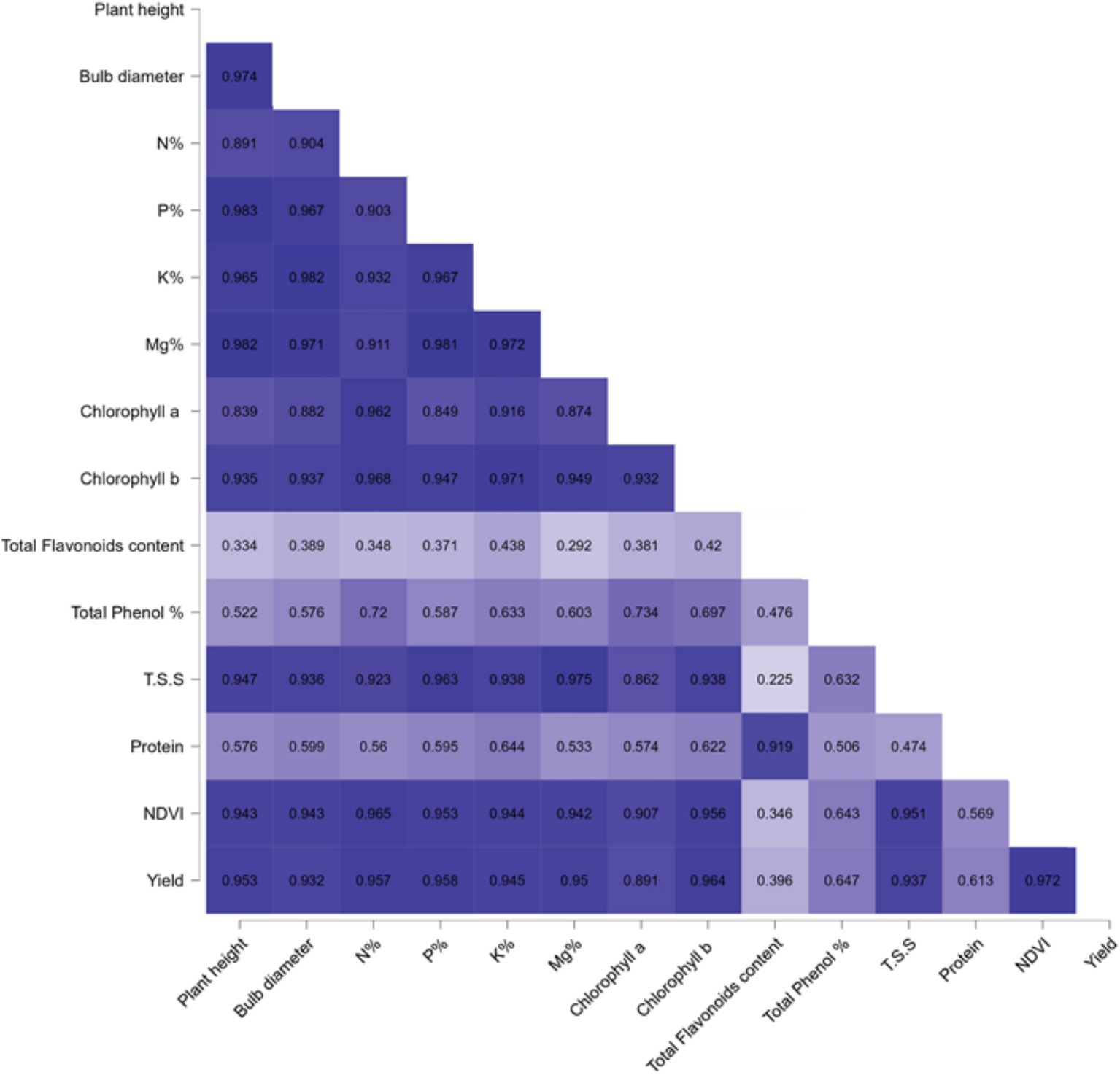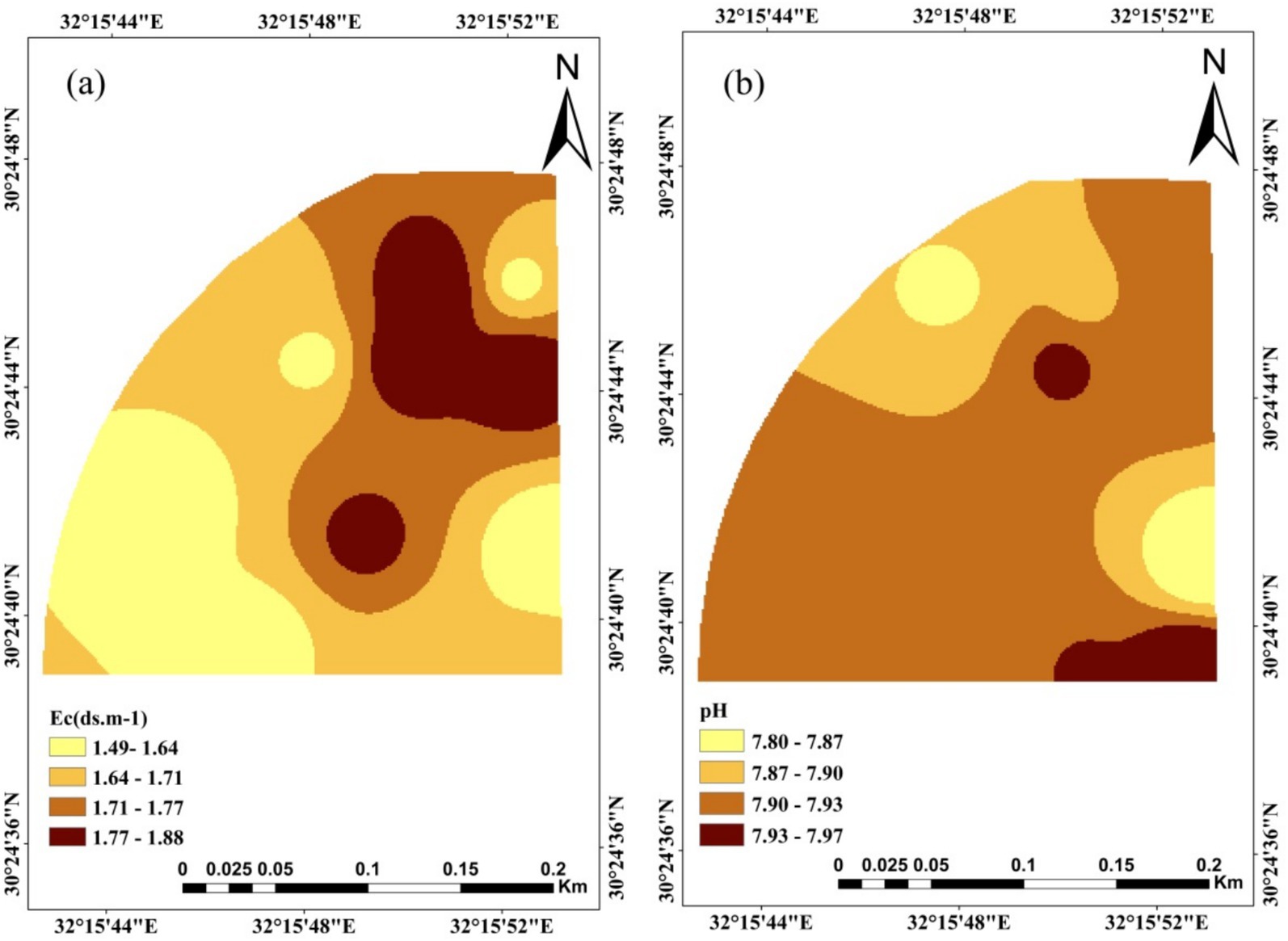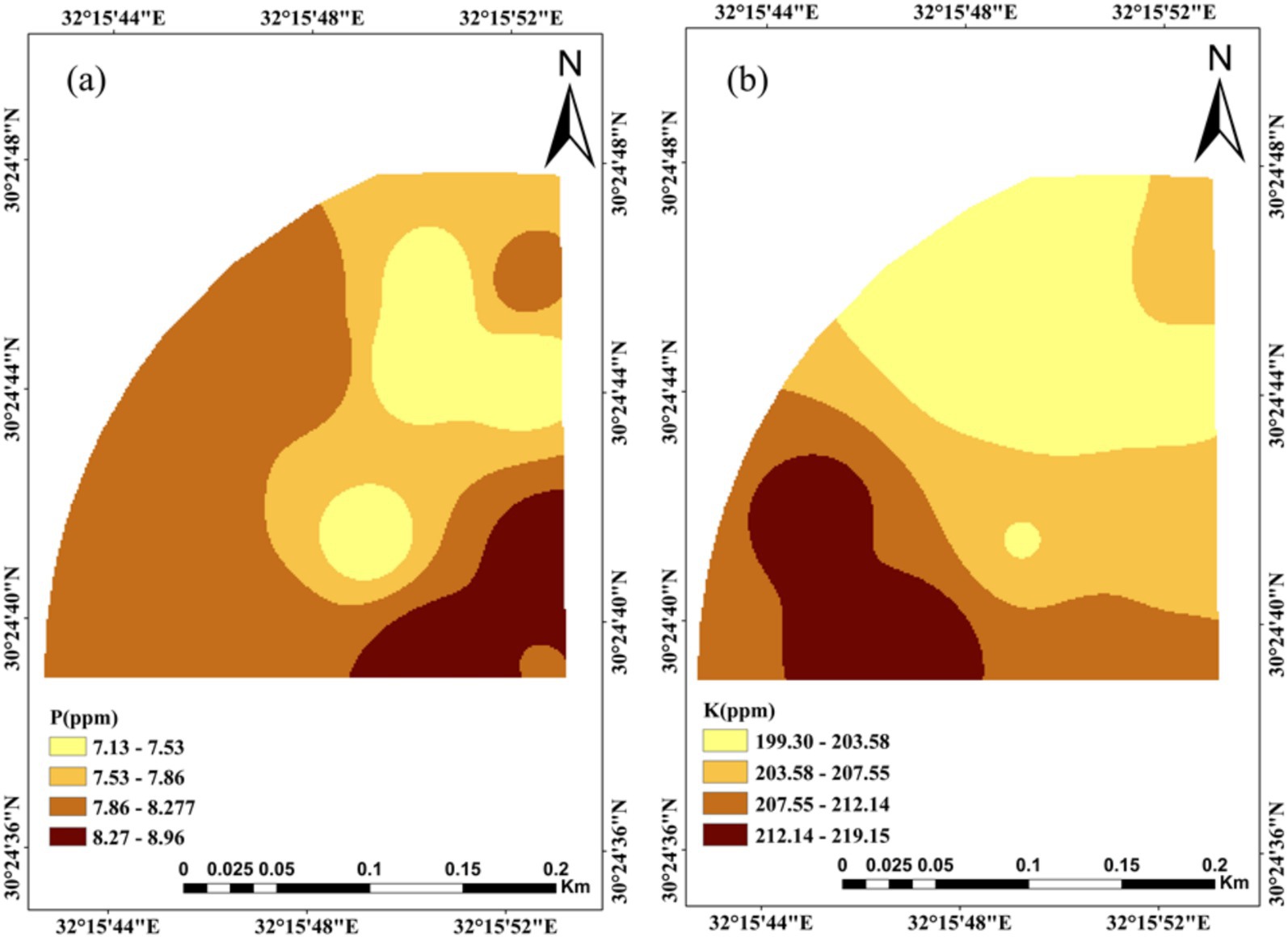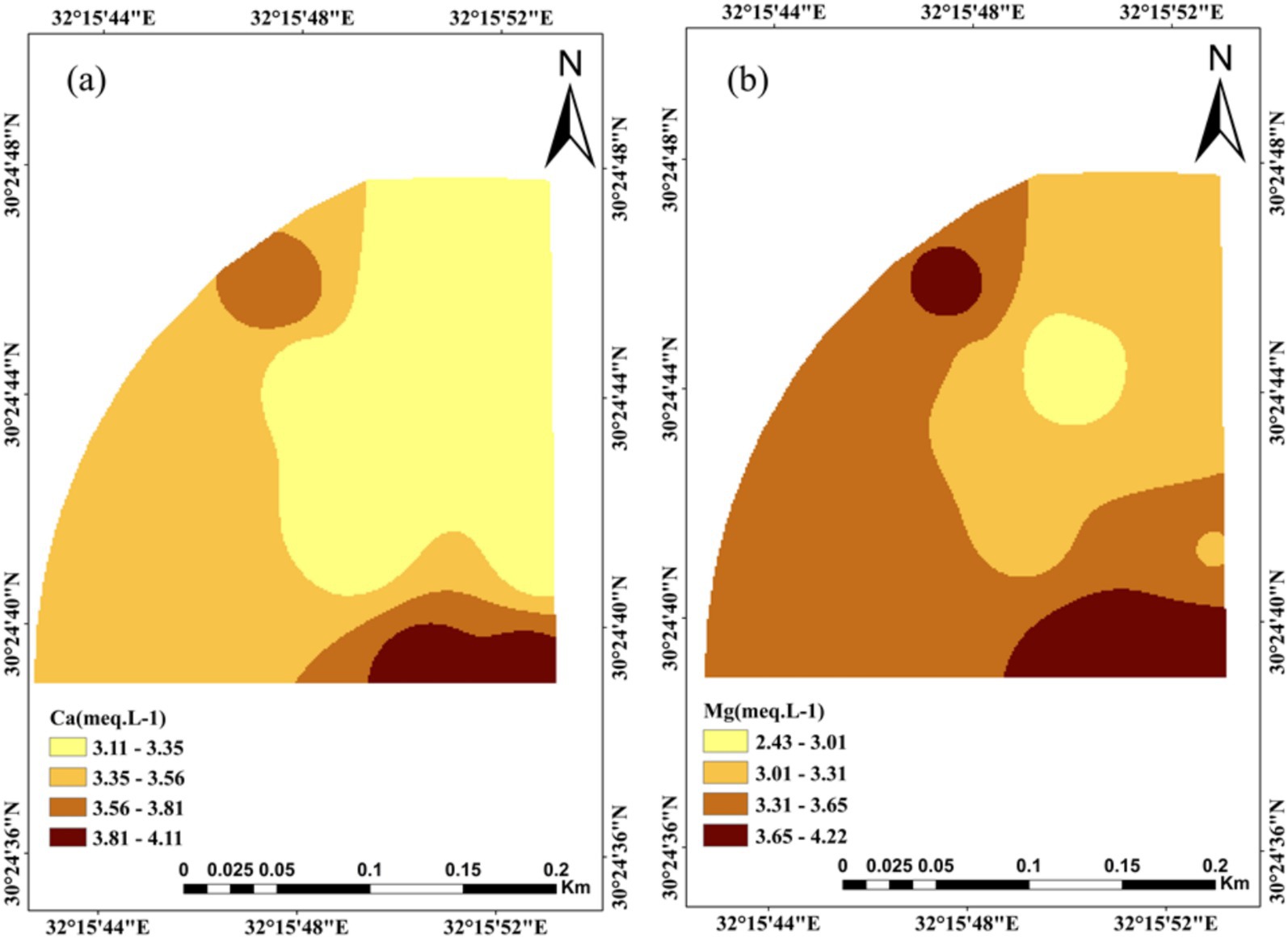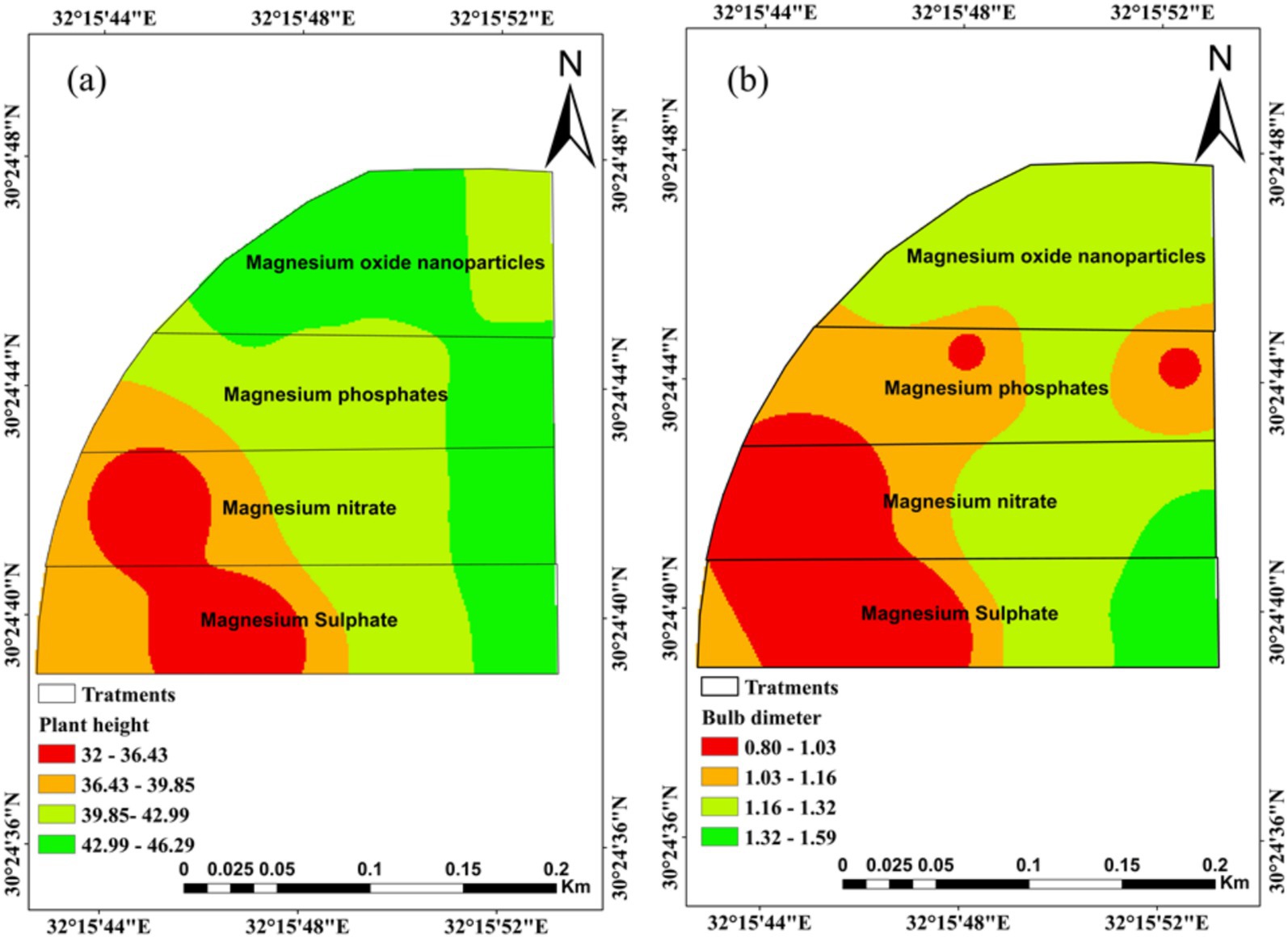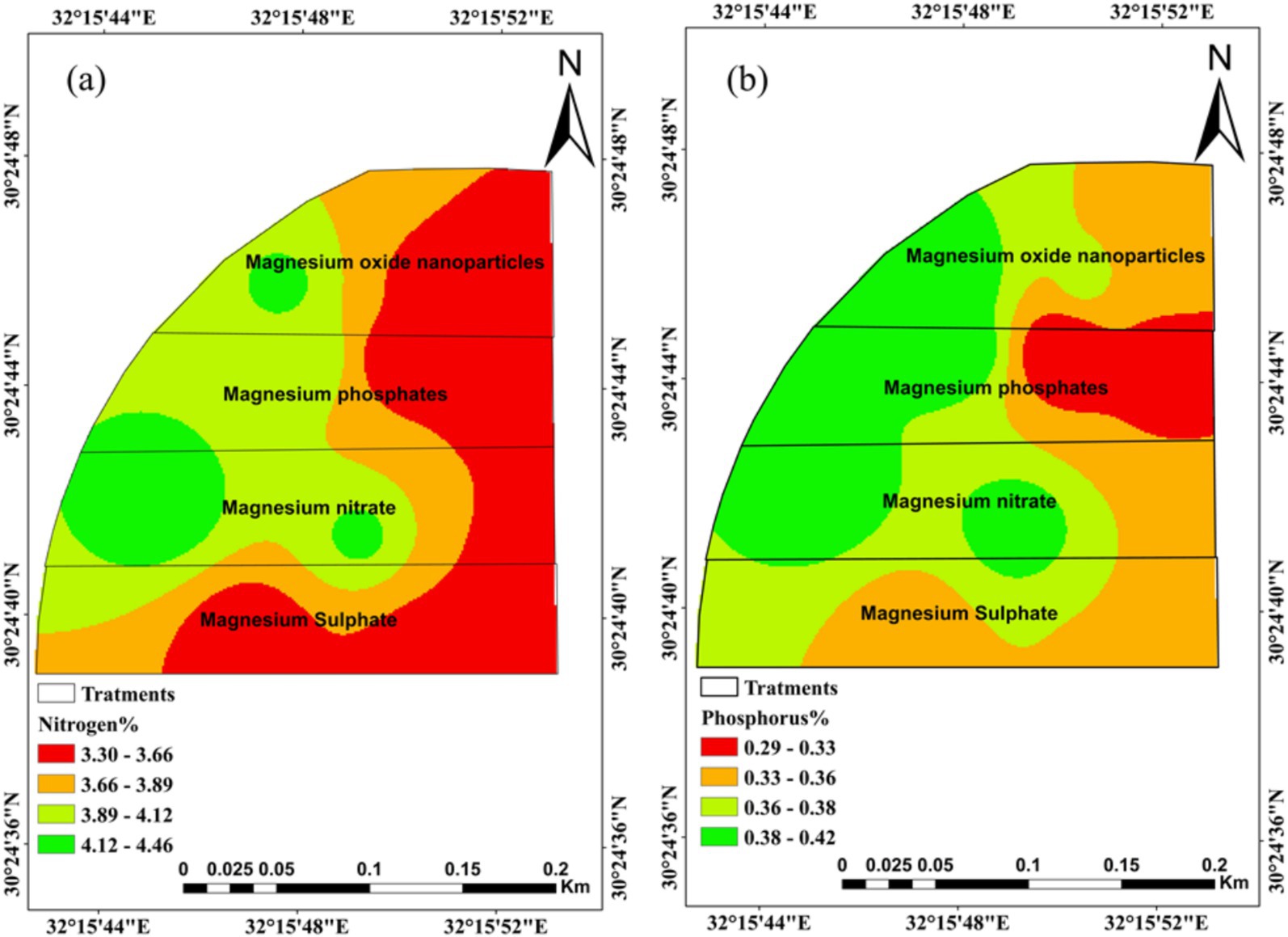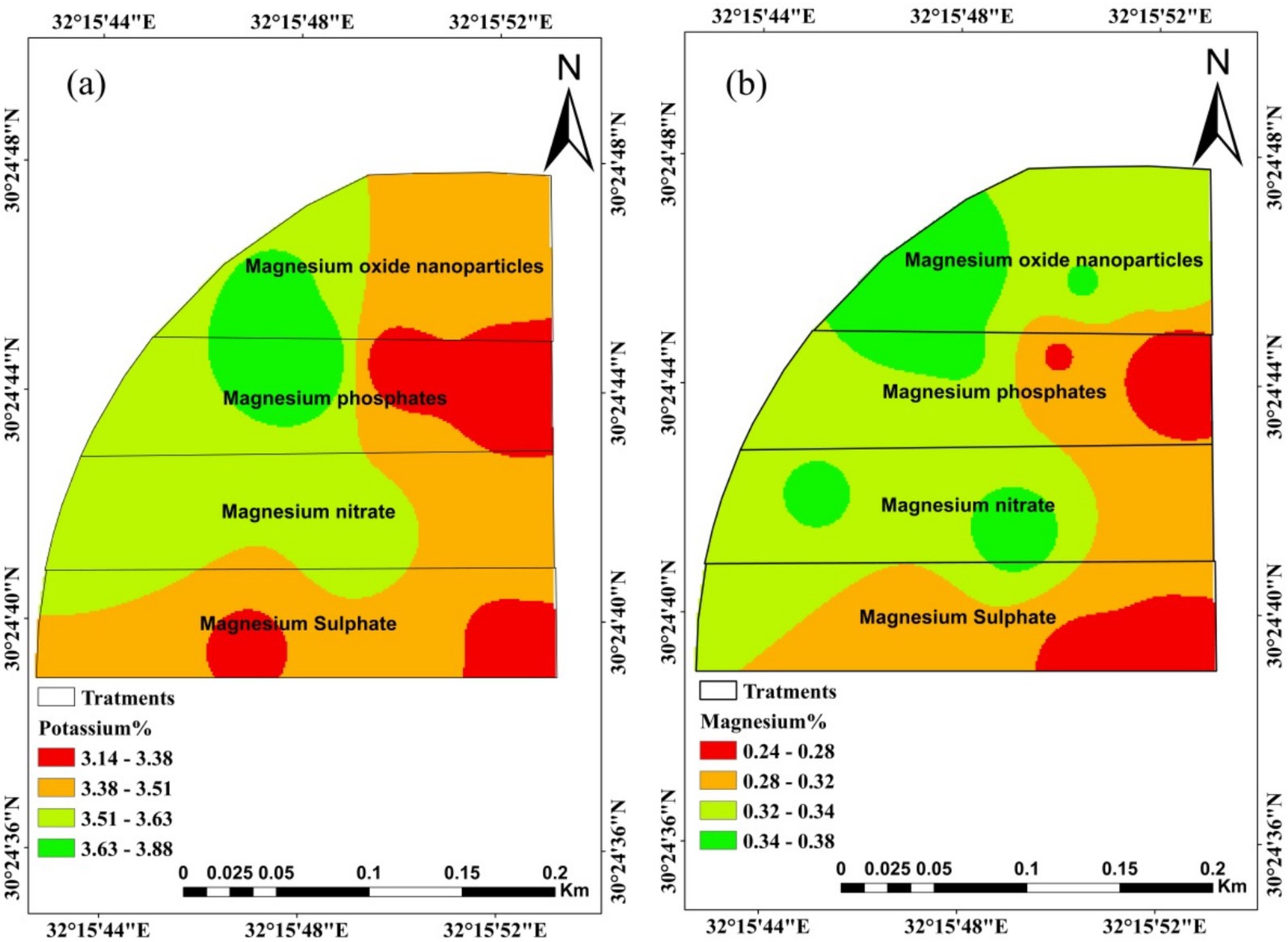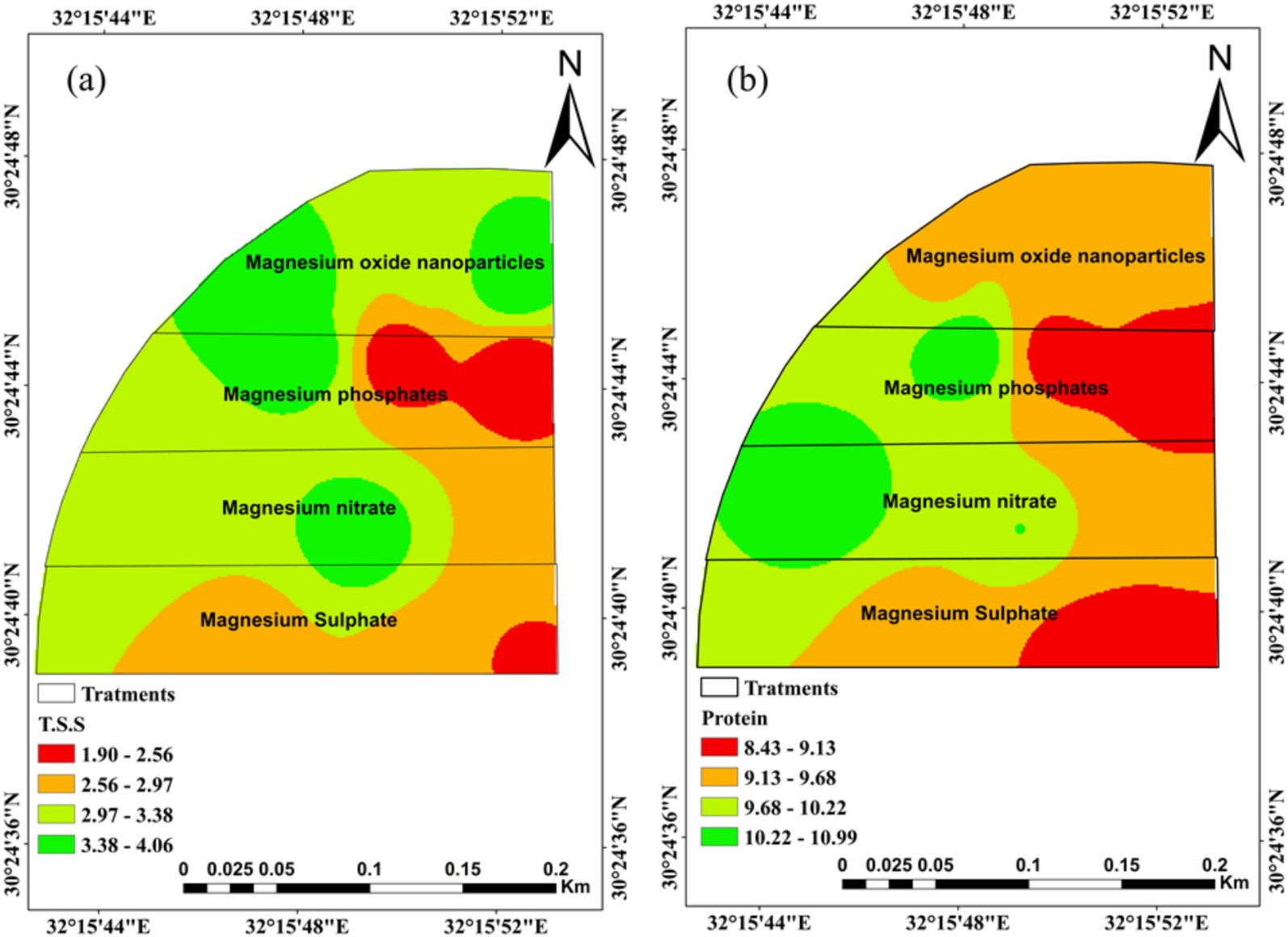- 1National Authority for Remote Sensing and Space Sciences (NARSS), Cairo, Egypt
- 2Department of Environmental Management, Institute of Environmental Engineering, RUDN University, Moscow, Russia
- 3Faculty of Agriculture, Cairo University, Giza, Egypt
Introduction: Precision farming is an agricultural management practice that addresses various challenges by observing and measuring the variability of field crops, utilizing accurate and timely information about agricultural resources. A fundamental aspect of precision farming is the use of site-specific management zones (SSMZs). SSMZs improve agricultural management by customizing treatments for specific production zones, thereby conserving resources while enhancing crop productivity and quality. This research aimed to investigate the application of magnesium fertilizer in SSMZs for Allium cepa, as opposed to traditional methods based on soil and plant attributes.
Methods: To achieve this, a 10-meter grid-sampling scheme was implemented across the field, comprising 12 points where soil samples were collected from the top 20 cm before planting green onions in June 2021. Normalized Difference Vegetative Index (NDVI) data during the harvest stage of the green onion growth cycle were sourced from Sentinel-2 satellite imagery at each sampling point. Yield mapping was performed at harvest. Key yieldlimiting factors were identified through stepwise multiple analyses, which included soil properties (such as organic matter) and canopy parameters (such as bulb diameter, phosphorus, magnesium, and NDVI).
Results: Overlay maps illustrated soil parameters, growth, and biochemical measurements, and evaluated the effect of foliar spraying with different magnesium sources on the growth, productivity, and quality of green onions, indicating three distinct SSMZs: zone (I), zone (II), and zone (III), with areas of 1.97 ha, 1.35 ha, and 2.79 ha, respectively. The use of magnesium oxide nanoparticles (nMgO) in a site-specific management zone resulted in a remarkable green onion yield of 152.14 tons/ha. The assessed soil properties and plant characteristics revealed that foliar applications of (nMgO) significantly improved the nutritional status, growth, and quality of green onions (Allium cepa L.).
Discussion: The modeling process effectively classified the study area into three management zones for soil treatments and three additional management zones for plant treatments. Implementing such a process will lower the costs of soil analysis and enhance overall agricultural income.
1 Introduction
Green onion (Allium cepa L.) has significant economic value in Egypt, serving as a crucial crop for local consumption and a key export commodity (El-Hamd et al., 2016). The quality of its growth relies on 17 essential nutrients, including magnesium, which are crucial for proper development. To ensure optimal growth quality and favorable plant development, these nutrients should be present in appropriate quantities, sourced, and balanced in appropriate ratios (Maathuis, 2009). Magnesium’s direct role in chlorophyll synthesis and photosynthesis enhances the visual appearance of plant tissues, resulting in greener leaves and increased mass deposition (Paulus et al., 2022). Foliar applications involve spraying liquid fertilizers directly onto plant leaves, providing a more efficient method for delivering both macro and micronutrients. This technique maximizes yield while minimizing losses (Rahman et al., 2017).
In Egypt, green onion production commonly neglects the spatial differences in soil and crop conditions. Many farmers prefer to apply uniform fertilizer management practices throughout the field, resulting in excessive input usage in areas with abundant nutrients and insufficient application in areas with limited nutrients (Ferguson et al., 2002). Such improper management practices lead to increased field management costs, reduced yields, and compromised crop quality.
The Normalized Difference Vegetation Index (NDVI) is closely associated with the physiological parameters of plants, including the leaf area index (LAI) and canopy properties, which influence crop yield and biomass (Sultana et al., 2014). NDVI has been regarded as a comprehensive measure of overall plant growth, incorporating various growth factors (Govaerts et al., 2007). In green onion cultivation, both the green leaves and the small white bulbs are harvested. High NDVI values, influenced by factors such as green leaf area and plant biomass levels, act as reliable indicators of canopy properties. Consequently, these canopy properties effectively predict the yield and quality of green onions (Chang et al., 2014). In GIS, spatial interpolation techniques are utilized to estimate attribute values at unsampled sites, facilitating the generation of spatially continuous data (Li and Heap, 2011).
Among interpolation methods, inverse distance weighting (IDW) emerges as one of the most widely employed techniques. This deterministic spatial interpolation model is preferred by geoscientists and geographers, partly due to its extensive integration into various GIS packages (Mirzaei and Sakizadeh, 2016), (Narany et al., 2014). The fundamental principle of the IDW method is based on the interconnectedness of attribute values between two points, where their similarity diminishes as the distance separating them increases. Typically, a power or exponential function is utilized to adjust the distance weight, capturing the spatial interaction between locations. The IDW method plays a critical role in predicting unknown attribute values at specified locations. For instance, inverse distance weights were employed to create representative maps depicting various soil qualities on the northwestern coast (Nady et al., 2022). To date, few studies have investigated the use of vegetation indices for delineating management zones to implement fertilizer management in fields planted with green onions in Egypt.
Researchers have laboriously relied on ArcGIS’s Spatial Model Builder and IDW interpolation in their studies on spatial variability in agricultural fields. A geospatial analytic model has achieved a more accurate delineation of SSMZ in agriculture. According to (Filintas et al., 2023), Different datasets, including soil properties, plant measurements, and remote sensing information, are all part of the knowledge that these methods seek to understand in site-specific management zones (Yuan et al., 2022). According to Hendawy et al. (2024), several approaches have been used to maximize agricultural productivity in various Delta fields and SSMz. Ranjan and Yadav (2024) investigated this information vacuum by describing SSMZs in fields of green onions. They use Spatial Model Builder and IDW interpolation to optimize magnesium (Mg) treatments to maximize crop yield. These results are added to the growing body of research that has shown the significance of precision agriculture in environmentally friendly farming methods and resource conservation (Lanauskas et al., 2021).
Precision agriculture (PA) is a crop management approach that considers the spatial and temporal variability of factors directly or indirectly impacting agricultural product yield or quality (Groher et al., 2020). PA soil and plant attribute maps are fundamental information sources (Moral et al., 2020). The typical process for creating these maps begins with field sampling, followed by map interpolation. Sampling density varies based on area size and resource availability (Pereira et al., 2022). The advancement of site-specific management (SSM) promotes the delineation of Management Zones (MZs) within a field tailored to specific applications. This approach aims to achieve uniformity in overall yield while optimizing profitability and desired outcomes within each MZ. These objectives include enhancing production quantity and quality while reducing input requirements (McBratney et al., 2005). Management Zones (MZs) typically rely on classification methods that consider the spatial characteristics of multiple variables collected in the field (Aggelopooulou et al., 2013). Some variables can be considered when identifying MZs, including crop yield, physical and/or chemical soil data, vegetation indexes, and even combinations of these variables (Gavioli et al., 2019).
In Egypt, Crop Management Zones (MZs) were established in 2011, resulting in significant reductions in the costs of N, P, and K fertilizers 25.14, 22.10, and 5.34%, respectively, under precision farming. These findings underscore the cost-effectiveness of precision farming methods (El Nahry et al., 2011). Field data collection serves as the initial phase in the implementation of precision agriculture (Rodriguez et al., 1977). Various data types contribute to defining management zones, including soil information, which encompasses parameters such as soil electrical conductivity (EC), organic matter (OM), pH levels, and soil nutrient concentrations (Fu et al., 2010; Marques et al., 2010); (2) crop information, including yield and quality parameters, which also play a role in defining management zones during precision agriculture implementation (Aggelopooulou et al., 2013), (Tagarakis et al., 2013). The vegetation index, such as the Normalized Difference Vegetation Index (NDVI), is a valuable tool for evaluating plant performance (Ali et al., 2022). To enhance the accuracy of management zone delineation, it is crucial to understand the relationship between MZs created from productivity maps and those produced from NDVI data collected via satellite imagery (Damian et al., 2020).
The objectives of this article were threefold: to characterize the factors’ spatial variability, delineate Management Zones (MZs) utilizing soil properties, plant measurements, and NDVI, employ the inverse-distance weighting (IDW) method, and delineate the optimal soil properties and plant measurements influenced by foliar magnesium application within the identified best MZs.
2 Materials and methods
2.1 Study area
The research was conducted on a 6.27-hectare green onion field situated in Abu Sultan, Ismailia Governorate, Egypt, at coordinates 30°24′43.95”N, 32°15′48.08″E (Figure 1). The experimental site features an arid climate, with an annual temperature of 24.56°C, which is slightly below Egypt’s average by 0.34%. Ismailia typically receives about 2.52 mm (0.1 inches) of precipitation annually, spread over 7.46 wet days, accounting for 2.04% of the year. The main soil texture in the region was identified as loamy sand. The research investigated the effect of foliar spray of various magnesium sources on green onion plants to enhance their nutritional status, growth, and quality under a pivot irrigation system. Planting began on 12 July 2021, and harvesting took place on 10 October 2021. Foliar spraying on the leaves was carried out 30 days after sowing during the vegetative development phase and again 60 days after sowing during the growth stage of green onion sprouts. The treatments included phenolic acid (magnesium chelate), magnesium phosphate (KAFOM Mg), magnesium sulfate, magnesium nitrate (Mg-L), and magnesium oxide nanoparticles (nMgO). A completely randomized design was used in the experimental setup.
Before the cultivation of green onions in June 2021, random soil samples were collected from the field using a grid-sampling method consisting of 12 grids (Figure 2). During each grid sampling, three samples were taken from the upper layer (0–20 cm) within a five-meter radius of each grid. The coordinates of each sampling site were recorded using a GPS device and later transported to the laboratory. Twelve composite soil samples were air-dried, ground to pass through a 2-mm sieve, and analyzed using standard methodologies. We measured the soil pH in a water suspension (1:2.5) with a glass electrode pH meter. The potassium bichromate titrimetric method was used to determine the organic matter (OM) content, the alkaline hydrolysis diffusion method assessed nitrogen (N) levels, the alkaline sodium bicarbonate extractant in a 20:1 ratio evaluated phosphorus (P) content, and the neutral ammonium acetate extraction method quantified potassium (K) levels.
2.2 Plant measurements
2.2.1 Growth measurements
Throughout growth, the plant’s height was monitored by measuring the distance from the surface to the apex of the longest leaf, and the bulb’s diameter was assessed perpendicular to the longitudinal axis at its widest diameter.
2.2.2 Biochemical measurements
The pigments involved in photosynthesis (chl. a, b) were measured in the laboratory. According to the results, 0.05 mL of the pigment extract was added to 0.95 mL of 80% buffered acetone (Pillai and Atiya, 2004).
Total soluble solids (T.S.S) were measured in the juice extracted from the white sheath leaves of each onion, with each determination replicated using a hand refractometer at 20°C.
Protein (mg/g): Green onion plants were dried in an oven at 70°C, ground, and analyzed for protein content following the method described by Company (1967).
The total flavonoid content (mg/100 g) was assessed using a colorimetric assay. One hundred microliters of extract were added to four milliliters of distilled water. Subsequently, 0.3 mL of 5% sodium nitrite was added. After 5 min, 0.3 mL of 10% aluminum chloride was injected. After 6 min, 2 cc of 1 M sodium hydroxide was added to the mixture. The solution was immediately diluted with 3.3 cc of filtered water and properly mixed. The absorbance was measured at 510 nm relative to a blank sample. Catechin served as the standard for the calibration curve. The extract’s total flavonoid concentration was quantified in milligrams of catechin equivalents per gram of sample (mg/g), according to Zhishen et al. (1999).
The total phenolic content was assessed using the Folin–Ciocalteu reagent, with results expressed as Total Phenol % (mg GAE.g−1 DW) (18). In conclusion, 0.5 mL of the extract was combined with 0.5 mL of Folin–Ciocalteu reagent. The solution was held at 25°C for 5–8 min before adding 2 mL of a 7.5% sodium carbonate solution, then the volume was adjusted to 8 mL with water. After 2 h, the absorbance was measured at a wavelength of 725 nm. Gallic acid served as the reference for the calibration curve. The total phenolic content was measured in milligrams of gallic acid equivalents per gram of sample (mg/g) (Dutta et al., 2024).
2.2.3 Nutrients
Samples of the green onion were ground and wet digested as described by Haluschak (1981), and their nitrogen (N), phosphorus (P), potassium (K) contents, and magnesium (Mg) were determined according to the methods. The concentrations of potassium (K) and magnesium (Mg) in the plant tissues were measured using an atomic absorption spectrophotometer (PerkinElmer 1,100 B), while phosphorus (P) was analyzed using the ammonium vanadate-amino naphthol method. For total nitrogen (N) determination, 50 mg of leaf powder was digested for 3 h at 320° C following the Kjeldahl method. After cooling, the clear digestate was diluted to exactly 20 mL. Aliquots of this solution were reacted with alkaline phenol and sodium hypochlorite in an alkaline medium (pH 11.5) in the presence of sodium nitroprusside as a catalyst, and the intensity of the resulting indophenol blue color was measured in a Hitachi U1100 spectrophotometer at 662 nm.
2.2.4 Yield components
During the harvesting period, all plants from each plot were collected to assess plant weight (g), yield per plot (kg), and total yield (kg/ha) after 120 days from sowing.
2.2.5 Normalized difference vegetation index (NDVI)
NDVI was calculated using Sentinel-2 satellite images obtained from the ESA Copernicus Open Access Hub in 2021. The images were acquired in GeoTiff format, featuring pixel dimensions of 10 m. The images acquired in 10 October 2021.
At the harvest stage, one image from the satellite was chosen for the green onion field under study. Satellite images displayed the highest quality, i.e., with no cloud cover in the area of study.
The NDVI was calculated from the satellite Sentinel −2 via location samples point using the SNAP 8.0 software according to Equation (1):
where NIR is the near-infrared region, and R is the red region. In Sentinel 2, the NIR corresponds to band 8 and the R to band 4.
2.3 Data analysis
Descriptive statistics, including the mean, standard deviation (SD), maximum, minimum, coefficient of variation (CV), and skewness, were calculated for each variable using IBM SPSS Statistics 22 software. The Kolmogorov–Smirnov statistic was used to evaluate the normality of all these variables. The primary yield-limiting factors for green onion in this study were examined using stepwise multiple regression analysis as the method for variable selection.
2.4 Creating variability maps
The inverse distance weighted (IDW) function in ArcGIS 10.4.1 software was used to produce interpolation of soil properties and parameters of green onion plants. It presents a good estimation of the spatial variable (Wang and Wang, 2012). This procedure is based on grid calculations concerning nearby points located within the radius of the user-defined search, according to the following Equation (2):
where zp is the value predicted at point P, zi is the z value at the determined point i, and di is the distance between point 0 and point ‘i’. This technique was used with 12 neighboring samples to estimate each grid point. A power of two was utilized to weigh the nearest points.
2.5 Spatial modeling for management zones
The locations of soil parameters were digitized to determine their geographic coordinates and calculate the weighted average value for each parameter. Additionally, plant measurements of green onions were analyzed using the Inverse Distance Weighting (IDW) interpolation method in ArcGIS 10.4.1.
2.6 Model building
To facilitate the creation of site-specific management zones (SSMZs), the Spatial Model Builder in ArcGIS was utilized to study the integration and analysis of diverse information. This technology allowed us to streamline the process by integrating NDVI data with soil characteristics and plant biochemical measures. The input datasets included soil properties (such as pH, organic matter, and magnesium), plant measurements (including bulb diameter, chlorophyll, and yield), and NDVI values gathered from Sentinel-2 satellite imagery. These datasets were converted into raster format, standardized to a consistent scale, and weighted based on correlation analysis, which assessed their relative influence on green onion production.
We created spatially continuous maps of critical parameters by interpolating data from unsampled sites using the Inverse Distance Weighting (IDW) method, which enabled the analysis of spatial variability. This phase relied heavily on identifying differences throughout the research area. We conducted a weighted overlay analysis to examine a separate map that illustrates areas with varying potential for green onion yield generated by combining these interpolated layers. Statistical criteria and suitability ratings were used to categorize this map into three management zones: highly suitable, moderately acceptable, and low suitability.
Spatial Model Builder was used to automate geoprocessing steps, and result visualization was easy. Utilizing IDW allowed for the precise collection of soil and plant characteristic spatial variability despite a restricted number of sample sites. The final result, which comprised a management zone map and comprehensive spatial maps for each parameter, provided an actionable framework for optimizing magnesium treatments and enhancing site-specific crop management.
To distinguish agricultural development priorities, the first step was identifying and creating vegetative and chemical measurements, soil resources, and land surface datasets. After identifying which datasets were required as inputs in an adequate format (raster format), the chosen inputs included pH, electrical conductivity (EC), and organic matter (O.M %), as well as nitrogen (N), phosphorus (P), potassium (K), calcium (Ca), magnesium (Mg), and plant growth parameters. These parameters included biochemical measurements such as plant height, bulb diameter, N%, P%, K%, Mg%, protein, total phenol, total flavonoid content, T.S.S, chlorophyll a and b, NDVI, and yield.
The second step involved reclassifying datasets by adjusting each to a common scale of values (e.g., from 1 to 4). Higher scale values were assigned to more appropriate attributes.
Finally, each input dataset could be assigned a percentage impact based on its importance to soil productivity, as specified. For all datasets, the total influence must equal 100%. The cell values of each input dataset were multiplied by their corresponding influence percentages (weights). The resulting cell values were summed to generate the final output dataset of this model, which identified the most suitable area for producing green onions with high productivity and quality characteristics under various magnesium treatments (Figure 3).
Given the extensive array of soil and plant characteristics utilized for decision-making, automated programs were integrated into ArcGIS-10.4.1 to identify site-specific management zones and address various study objectives. The model building involved the creation and customization of geoprocessing workflows. The model builder has been implemented in site-specific management zones (Nady et al., 2022; Jalhoum et al., 2022; AbdelRahman and Tahoun, 2019). For example, soil quality was evaluated using a geostatistical approach within the GIS model builder (Noori and Panda, 2016), which also effectively established multivariate regression models based on digital image values related to site-specific onion growth parameters through GIS modeling. The flowchart for this site-specific model is shown in Figure 4. Each step is represented by boxes indicating input information (blue), processes (yellow), and output (green). The output from the first stage served as the input for the next stage. The procedure at each stage was simple, utilizing the drag-and-drop functionality from the tools available in the GIS toolbox, such as extract and reclassify. This study consisted of two stages: (1) examining spatial variability and comparing various geostatistical methods and (2) performing descriptive statistics using SPSS software. The methodology and steps of this study are illustrated in Figure 5.
3 Results and discussion
3.1 Descriptive statistics
Table 1 presents descriptive information about the chemical characteristics of the soil. The soil exhibited a low coefficient of variation (CV = 2.38%), was alkaline, and had a pH range from 7.80 to 7.97. The mean organic matter content was 0.49%. The available nitrogen, phosphorus, and potassium content in the soil was deemed acceptable for green onion growth, with mean values of 21.21 ppm, 7.95 ppm, and 206.15 ppm, respectively. Magnesium in the soil had the highest coefficient of variation at 14.05%. Regarding the properties of green onion plants, potassium levels ranged from 3.14 to 3.88%, with a low coefficient of variation (CV = 6.19%). The quality standards for exporting green onions were determined by plant height and bulb diameter, with results indicating means of 41.91 cm and 1.21 cm, respectively. The mean NDVI value at the harvest stage was 0.56, showing intermediate spatial variability (CV < 18.84%). The green onion yield was recorded at 49.91 tons/m2, demonstrating significant variation by region (CV = 43.86%).
The Pearson correlation coefficients for all attributes used in the study are shown in Figures 6, 7. A significant association among all parameters included in the study was found at the 0.05 and 0.01 probability levels. The study indicated that most soil parameters and yield had a positive relationship, with a notable correlation coefficient of 0.97 between yield and organic matter, electrical conductivity (EC), available nitrogen, and pH, particularly for organic matter at the 0.01 probability level. The correlation coefficients between yield and available P, available K, Ca, and Mg were 0.37, 0.71, 0.44, and 0.95, respectively. Figure 6 illustrates the Pearson correlation matrix of soil factors and yield.
The investigation into green onion production revealed strong positive associations (p < 0.01) with organic matter, bulb diameter, phosphorus, magnesium, and NDVI, indicating that these variables were the primary limiting factors for green onion growth quality.
3.2 Geospatial analysis for input parameters
3.2.1 Spatial distribution of some soil properties
The IDW interpolation method was used to convert the spatial data on soil into digital databases of soil chemical characteristics (EC, pH, OM%, N, P, K, Ca, and Mg) for generating site-specific management zones (SSMZ). The soil variability maps are illustrated in Figures 8–11.
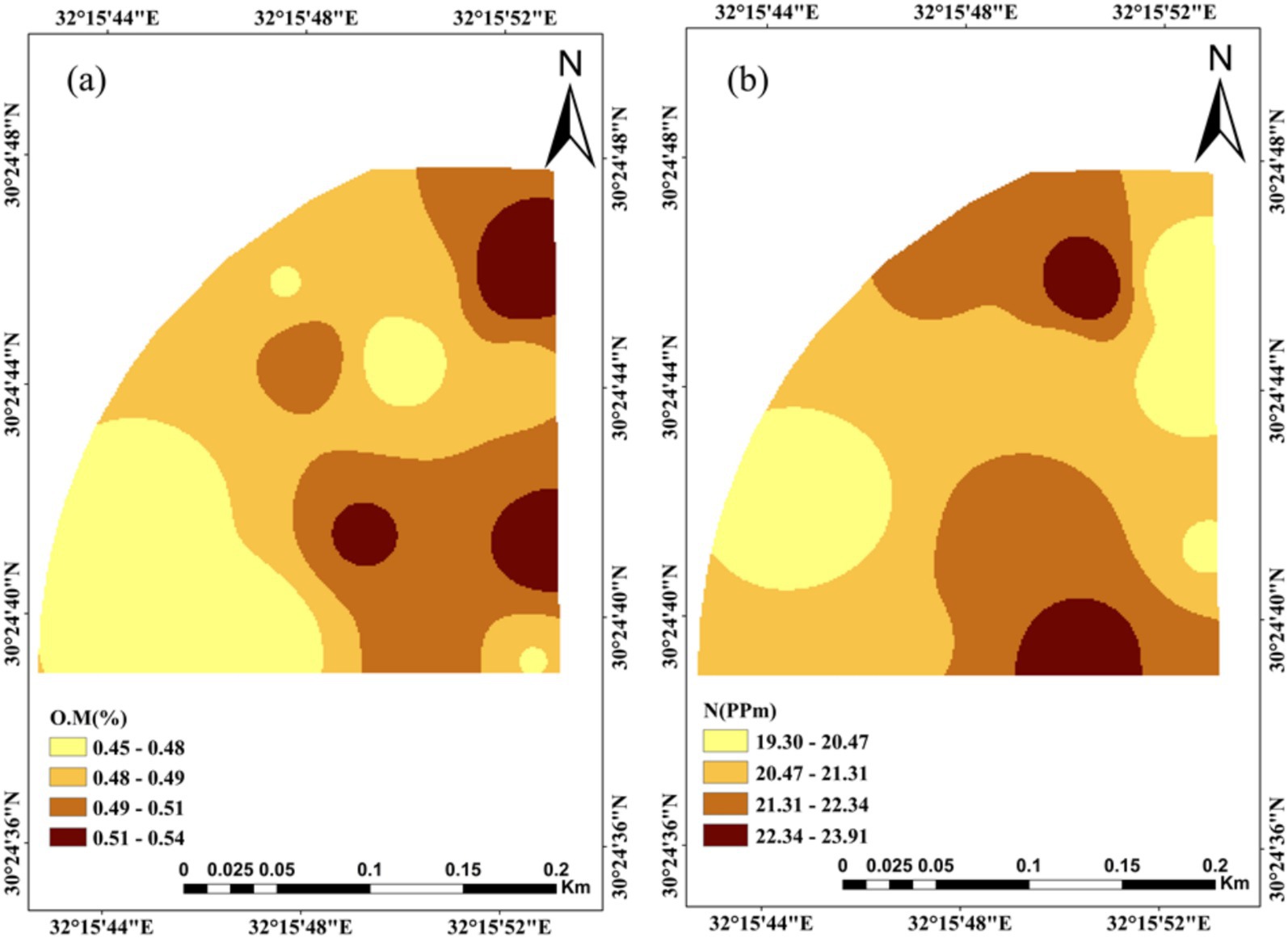
Figure 9. Spatial distribution of the soil parameter “(a) Organic Matter (O.M.) % – (b) Nitrogen (N)”.
Electrical conductivity (EC) values range from 1.49 to 1.88 (dS/m), as shown in Figure 8A. The highest value is between 1.77 and 1.88, while the lowest is from 1.49 to 1.64. The soil pH presented in Figure 8B has an alkaline range of 7.8 to 7.97. The variability map for soil organic matter (OM %) shows values ranging from 0.45 to 0.54, as illustrated in Figure 9A. Figure 9B displays the variability range of available nitrogen, which is between 19.3 and 23.92 ppm. Phosphorus values, as detailed in Figure 10A, fall within the 7.13–8.96 ppm range. The range with the lowest value is 7.13–7.53, while the range with the highest value is 8.27–8.96. Potassium values are shown in Figure 10B within the range of 199.3 to 219.15 ppm. Calcium values range from 3.11 to 4.11 (meq/L), as depicted in Figure 11A. Conversely, magnesium values fluctuate between 2.43 and 4.23 (meq/L), illustrated in Figure 11B. This spatial variability in magnesium content reveals a strong correlation with plant growth, as areas with higher magnesium levels consistently show better NDVI values and yield.
3.2.2 Spatial distribution of some green onion measurements
The IDW interpolation method was employed to convert the field measurements of green onion plants into digital databases of vegetative and chemical characteristics, including plant height, bulb diameter, N-P-K, Mg, chlorophyll a, b, total flavonoids, total phenols, T.S.S., protein, NDVI, and yield, for the creation of site-specific management zones (MZ). The resulting maps are illustrated in Figures 12–18.
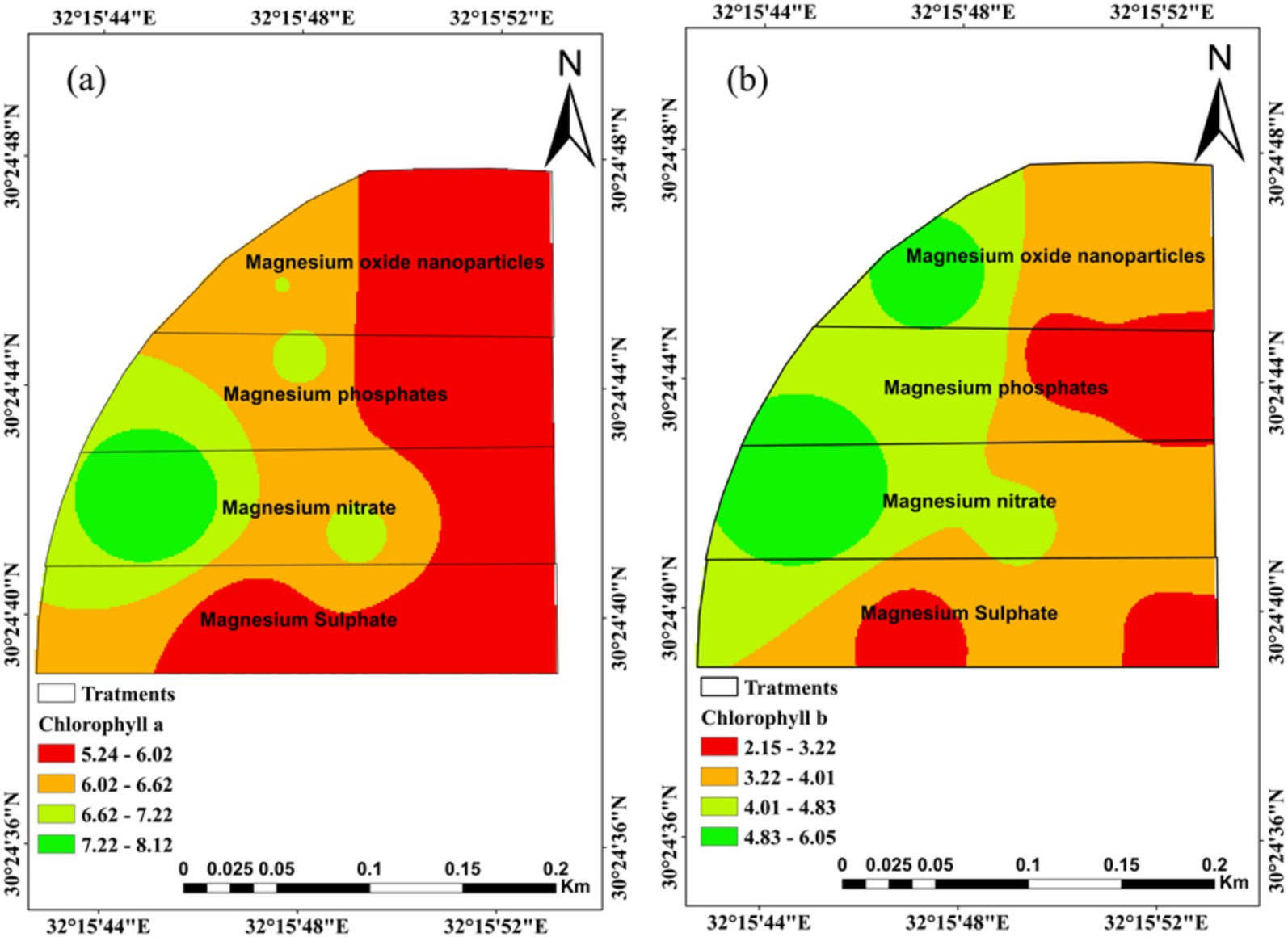
Figure 15. Spatial distribution of green onion measurements: (a) chlorophyll a and (b) chlorophyll b levels.
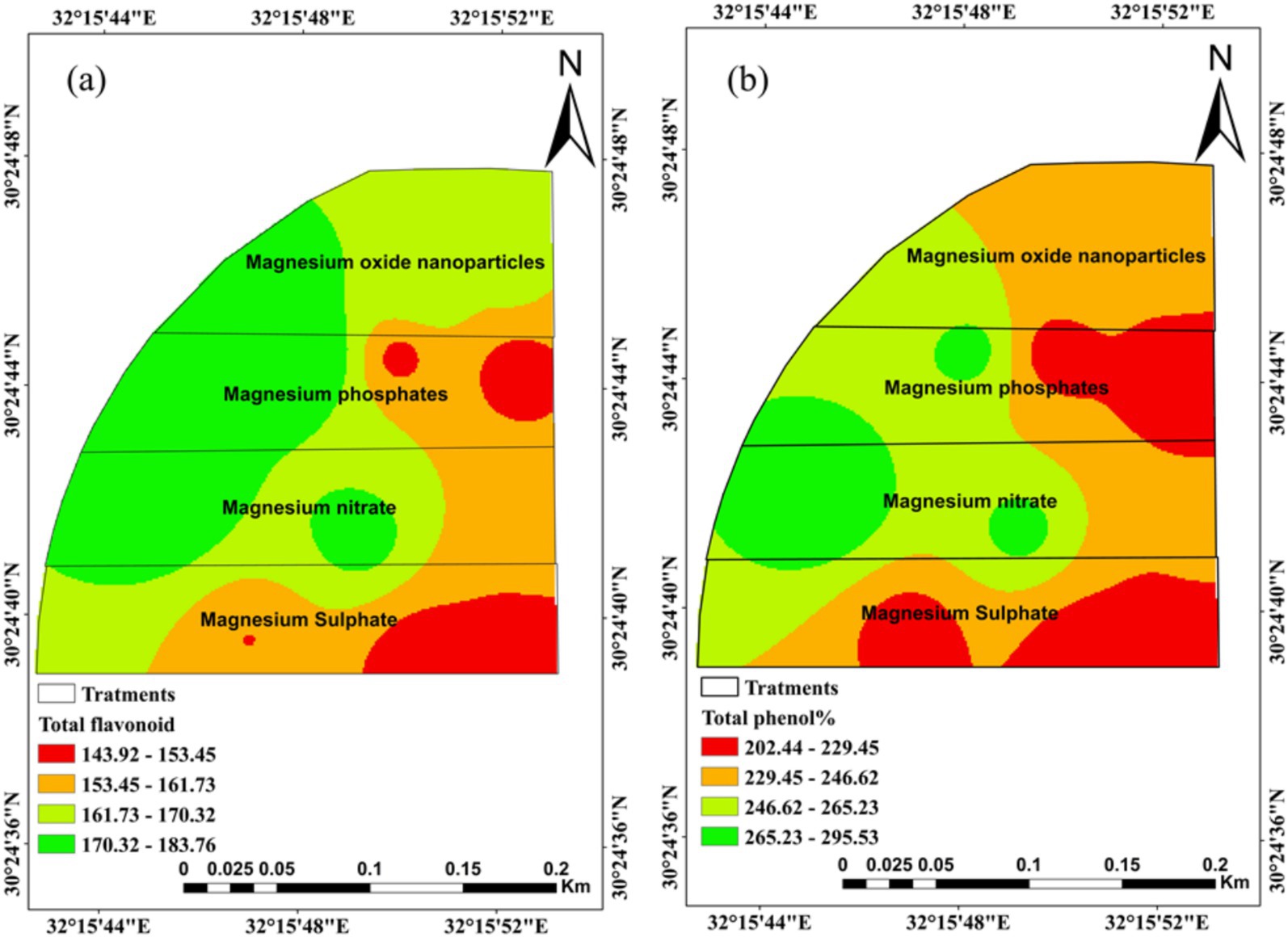
Figure 16. Spatial distribution of green onion measurements: “(a) total flavonoid– (b) total phenol”.
As shown in Figure 12A, the values for plant height range from 32 to 46.29 cm. The largest value ranges from 36.43 to 42.99 cm, while the lowest is 32 cm. The range of bulb diameter is illustrated in Figure 12B as 0.8 to 1.5 cm. Figure 13A indicates that nitrogen varies between 3.3 and 4.4% in the interpolation map. The range of phosphorus values from 0.29 to 0.41% is depicted in Figure 13B. Potassium values, ranging from 3.14 to 3.88%, are described in Figure 14A. Figure 14B presents magnesium readings in the range of 0.24 to 0.38 ppm. According to Figure 15A, the range for chlorophyll values is from 5.24 to 8.13 mg/g F.W. Conversely, Figure 15B shows that the range of values for chlorophyll b values is from 2.15 to 6.05 mg/g F.W.
According to Figure 16A, total flavonoid levels can range from 143.92 to 183.76 (mg\100 g). The maximum value is 170.33 to 183.76 (mg\100 g), while the lowest value is 143.92 to 153.45 (mg\100 g). Figure 16B shows the total phenol percentage, which ranges from 202.44 to 295.53 (mgGAE.g1 D.W).
According to Figure 17A, the T.S.S. value in the interpolation map ranges from 1.90 to 4.06 (mg/g D.w.). The range of results for protein is 8.43 to 10.99 (mg/g), as shown in Figure 17B. The NDVI values, ranging from 0.37 to 0.75, are illustrated in Figure 19A. Figure 19B displays yield values from 17.31 to 86.49 (ton/m2). Areas with higher NDVI values consistently correlate with higher green onion yields, highlighting NDVI’s role as an effective indicator of plant health and productivity. The highest yield value falls between 66.95 and 86.49 ton/m2, while the lowest is between 17.31 and 40.91 ton/m2.
3.2.3 Site-specific management zones map
Management zones included two categories: soil resources and plant growth and biochemical measurements. Soil resources include pH, electrical conductivity (EC), organic matter (O.M. %), available nitrogen (N), available phosphate (P), available potassium (K), calcium (Ca), and magnesium (Mg). Plant growth and biochemical measurements comprise plant height (cm), bulb diameter (cm), N%, P%, K%, Mg%, protein (mg/g), total phenols, total flavonoid content (mg/100 g), T.S.S. (mg/g Dw), chlorophyll A, B (mg/g F.W.), NDVI, and yield (ton/m2). Based on the results from soil resource overlay maps, vegetative growth, biochemical measurements, and the current land suitability for green onions, three site-specific management zones (SSMZ) were identified (Figure 17).
3.2.3.1 Zone (I)
This zone is characterized by loamy sand and covers 1.97 hectares. It is ideal for producing green onions with high-quality characteristics. It has an electrical conductivity of 1.71 dS/m, a pH of 7.93, organic matter at 0.49%, nitrogen at 21.31 ppm, phosphorus at 8.27 ppm, potassium at 203.58 ppm, calcium at 3.35 meq/100 g, and magnesium at 3.31 meq/100 g, as shown in Figure 19A. Green onion plants in Zone (I) have a height of 46.29 cm, a bulb diameter of 1.32 cm, nitrogen content of 3.66%, phosphorus at 0.36%, potassium at 3.51%, magnesium at 0.34%, and a yield of 53.93 to 152.14 tons per hectare, as shown in Figure 19B.
3.2.3.2 Zone (II)
This zone covers approximately 1.35 ha. The contents of this zone include an electrical conductivity (EC) of 1.64 ds/m, a pH of 7.93, organic matter at 0.51%, nitrogen at 22.34 ppm, phosphorus at 8.27 ppm, potassium at 207.55 ppm, calcium at 3.81 (meq/l), and magnesium at 3.65 (meq/l). Among the vegetative characteristics of green onion plants in Zone (II) are a plant height of 43 cm, a bulb diameter of 1.32 cm, nitrogen at 3.66%, phosphorus at 0.38%, potassium at 3.51%, magnesium, chlorophyll a at 7.22 (mg/g F.W), chlorophyll b at 4.01 (mg/g F.W.), total flavonoids at 161.73 (mg/100 g), T.S.S at 2.97 (mg/g Dw), protein at 9.68 (mg/g), and a yield of 86.57 tons/ha.
3.2.3.3 Zone (III)
This zone covers approximately 2.79 ha. The EC of this zone is 1.64 ds/m, with a pH of 7.93. Organic matter is 0.48%, nitrogen is 21.31 ppm, phosphorus is 8.27 ppm, potassium is 212.15 ppm, calcium is 3.81 meq/L, and magnesium is 3.65 meq/L.
Among the vegetative characteristics of green onion plants in Zone (III) are a plant height of 39.85 cm, a bulb diameter of 0.8 cm, nitrogen content of 3.30%, phosphorus content of 0.35%, potassium content of 3.51%, magnesium content of 0, chlorophyll at 5.24, total flavonoids at 170.32 (mg/100 g), total soluble solids (T.S.S) at 2.97 (mg/g Dw), protein content of 9.68 (mg/g), and a yield of 146.89 tons/ha (Figure 20; Table 2).
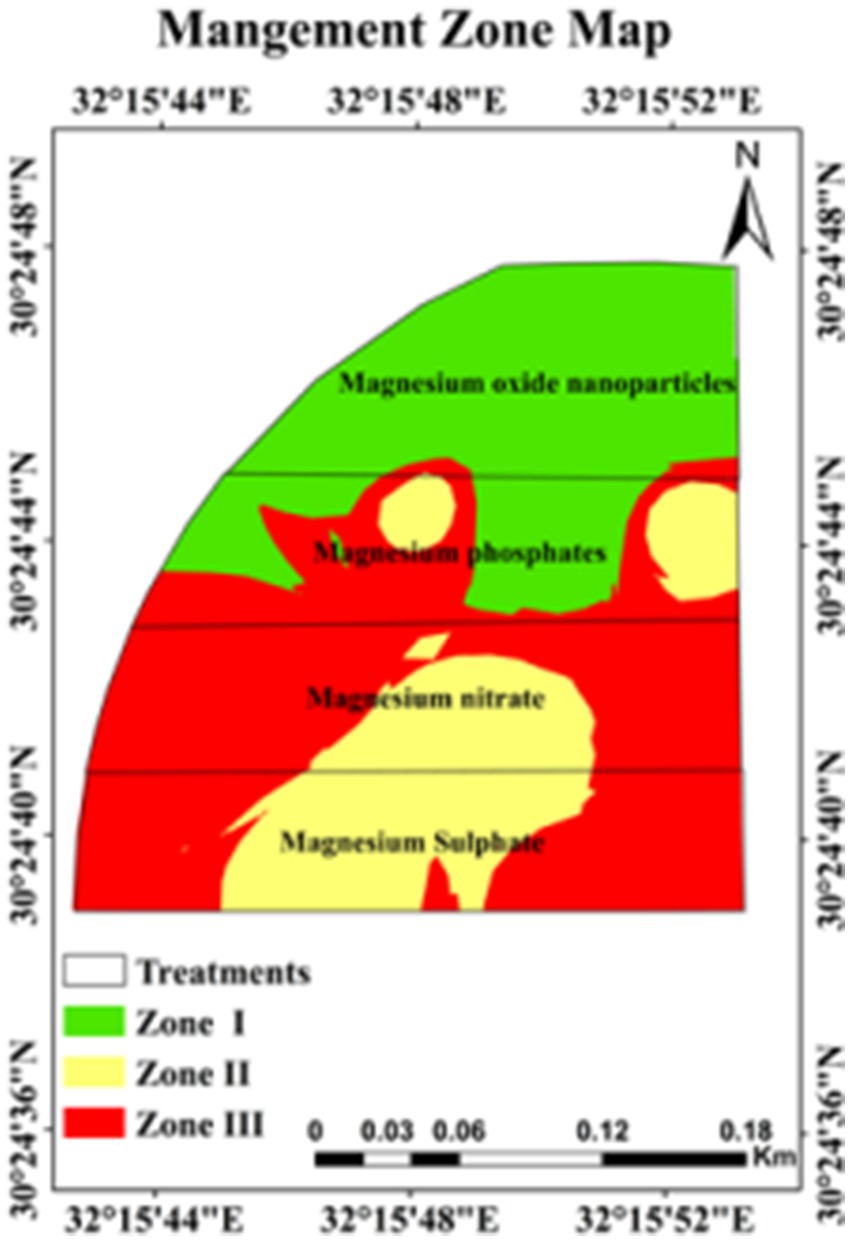
Figure 20. Map of the management zone based on measurements of soil properties and canopy parameters.

Table 2. Total area for management zones based on measurements of soil properties and canopy parameters.
4 Discussion
To enhance the nutrient status, growth, and quality of green onion plants grown under a pivot irrigation system, this study investigated the effects of various magnesium sources on the plants. Foliar spraying of magnesium is one method for correcting magnesium deficiencies in crops. This application of foliar can be an optimal approach for increasing crop output and achieving a rapid response (Fageria et al., 2009). The foliar application of magnesium directly to plants has been shown to increase their leaf magnesium content, photosynthesis rate, and biomass accumulation (Jezek et al., 2015). It has been shown that using foliar applications of magnesium oxide nanoparticles (nMgO) on green onions enhances yield (Hassan et al., 2023). Magnesium plays a key role in chlorophyll synthesis and photosynthesis, directly influencing plant growth and yield. In this study, areas receiving Mg supplementation showed significant improvements in yield and bulb diameter, aligning with previous findings (Filintas et al., 2023). When applied as a foliar spray, MgONPs provide plants with a readily absorbable form of magnesium. The enhanced availability of magnesium improves photosynthesis efficiency, leading to increased biomass production and yield (Cai et al., 2018). Magnesium also plays a key role in activating enzymes involved in metabolic processes across different plants. It is an essential cofactor for enzymes responsible for glucose metabolism, protein synthesis, and energy transfer. Delivering MgO nanoparticles through foliar spraying enhances nutrient uptake and stimulates the production of these enzymes, ultimately boosting plant development and yield (Wang et al., 2020). The spatial variability of soil and plant characteristics is a key factor in devising effective agricultural management strategies to maximize crop production and minimize losses (Morgan et al., 2017).
This section addresses the interpolation method for several specific soil chemical properties and biochemical properties of plants. These properties include EC, pH, organic matter (O.M.%), nitrogen (N), phosphorus (P), potassium (K), calcium (Ca), magnesium (Mg), plant height, bulb diameter, N%, P%, K%, Mg%, protein, total flavonoid content, total phenol, T.S.S., chlorophyll a, b, NDVI, and yield. The technique being evaluated is Inverse Distance Weighted (IDW), a relatively new method that is widely utilized for interpolating soil and plant parameters. IDW is, however, an easier approach to employ (Morgan et al., 2017).
Descriptive analyses were conducted after the collection and investigation of soil samples from the field (Srivastava et al., 2008). The pH of the alkaline soil ranged from 7.80 to 7.97, with a low coefficient of variation (CV = 2.38%). The mean content of OM was 0.49%. The study found that soil N, P, and K content were acceptable for green onion growth, with mean values of 21.21 ppm, 7.95 ppm, and 206.15 ppm, respectively. The highest coefficients of variation were observed in soil magnesium (14.05%). According to previous research, magnesium has larger coefficients of variation than many other soil nutrients (Ishfaq et al., 2022; Liu et al., 2021; Wang et al., 2020). The mean levels of N, P, K, and Mg in the soil were 21.21 ppm, 7.95 ppm, 206.15 ppm, and 3.41 meq/L, respectively, and were favorable for the growth of green onion plants. Plant height and bulb diameter were the two most important field measurements analyzed for the characteristics of green onion plants, including export quality standards (Nourbakhsh and Cramer, 2022). The harvest stage showed intermediate spatial variability, with a mean NDVI value of 0.56, while green onion yield varied significantly across regions. The study found strong positive associations between soil variables, canopy parameters, and green onion production, indicating that organic matter, bulb diameter, phosphorus, magnesium, and NDVI are the primary limiting factors. The efficiency of determining management zones can be improved by utilizing NDVI data from satellite images (Damian et al., 2020).
The study identified three management zones (AEZ) for green onions based on soil resources (Zeraatpisheh et al., 2022), plant growth, biochemical measurements (Chang et al., 2014), and land suitability, using overlay maps and modeling applications. To enhance fertilizer management, boost crop productivity, and tailor magnesium treatments to specific zone conditions, it was essential to delineate management zones (MZs). Soil characteristics, plant growth metrics, and NDVI data were utilized to establish various management zones (MZs). In Zone I, which is characterized by high levels of organic matter and magnesium, minimal magnesium inputs were necessary to maintain high output when plant development variables such as NDVI and bulb diameter were favorable. Zone II presented more moderate circumstances, requiring additional magnesium to improve nutrient availability and increase output. Zone III exhibited low levels of organic matter and magnesium, necessitating more magnesium treatments to close the gaps and enhance plant growth. Foliar magnesium, particularly in the form of nMgO, was applied to address the specific needs of each zone (Filintas et al., 2023). We evaluated crop growth and quality in each area to assess the effectiveness of these methods. Zone I produced the best yield with smaller amounts of Mg, while Zone III showed significant improvements in growth and quality when provided with higher amounts. The results show that MZs are important for determining appropriate nutrients and highlighting the benefits of managing resources based on specific site requirements to improve crop growth (Yuan et al., 2022). Zone I is highly suitable for producing green onion plants with superior qualities (Jalhoum et al., 2022). The treatment with magnesium oxide nanoparticles (nMgO) represents a significant aspect of Zone I.
5 Conclusion
This investigation employed geostatistical tools to quantify the spatial variations of specific management zones concerning soil and plant qualities. The data were aggregated into three management zones using principal component analysis and the Inverse Distance Weighting (IDW) interpolation method. The management zone for soil properties included electrical conductivity, pH, organic matter, nitrogen, phosphorus, potassium, calcium, and magnesium. Meanwhile, the management zone for plant properties considered plant height, bulb diameter, N-P-K, magnesium, chlorophyll a and b, total flavonoids, total phenols, total soluble solids, protein, NDVI, and yield. The results revealed three distinct site-specific management zones (SSMZs): zone I, zone II, and zone III, with areas of 1.97 ha, 1.35 ha, and 2.79 ha, respectively. The effect of magnesium oxide nanoparticles (nMgO) in site-specific management zones contributed to a significant green onion yield of 152.14 tons/ha. Zone I exhibited the highest productivity, significantly influenced by foliar applications of magnesium oxide nanoparticles (nMgO). Therefore, to enhance green onion yields, careful management of magnesium oxide nanoparticles (nMgO) is essential in these areas. NDVI data derived from satellite Sentinel-2 images effectively defined management zones and assessed plant health conditions. Results indicated that Zone I had the highest NDVI value under the influence of nMgO. The application of magnesium oxide nanoparticles demonstrated considerable improvement in the nutritional status, growth, and quality of green onions (Allium cepa L.), as evidenced by the indicators of soil and plant qualities analyzed in this case study. These findings illustrate the potential of geospatial tools in precision agriculture, providing scalable solutions for enhancing productivity and sustainability in resource-limited farming systems.
Data availability statement
The raw data supporting the conclusions of this article will be made available by the authors, without undue reservation.
Author contributions
AA: Conceptualization, Data curation, Formal analysis, Investigation, Methodology, Project administration, Resources, Software, Supervision, Validation, Visualization, Writing – original draft, Writing – review & editing. MA: Conceptualization, Formal analysis, Methodology, Writing – review & editing. NM: Conceptualization, Data curation, Formal analysis, Investigation, Methodology, Project administration, Software, Writing – original draft. NR: Methodology, Validation, Writing – review & editing. DK: Data curation, Writing – review & editing. HH: Methodology, Visualization, Writing – review & editing. EA: Methodology, Project administration, Writing – review & editing. MJ: Data curation, Formal analysis, Investigation, Methodology, Software, Writing – original draft. A-AB: Formal analysis, Validation, Visualization, Writing – review & editing.
Funding
The author(s) declare that financial support was received for the research, authorship, and/or publication of this article. This study was supported by National Authority of Remote Sensing and Space Science (NARSS) in Cairo, Egypt, and Cairo University in Giza, Egypt and the RUDN University Strategic Academic Leadership Program.
Acknowledgments
The authors would like to thank the National Authority of Remote Sensing and Space Science (NARSS) in Cairo, Egypt, and Cairo University, Giza, Egypt. This publication has also been supported by the RUDN University Scientific Projects Grant System, project number [202787-2-000].
Conflict of interest
The authors declare that the research was conducted in the absence of any commercial or financial relationships that could be construed as a potential conflict of interest.
The reviewer NSS declared a shared affiliation with the authors AMA, NM, MJ, MA, and AB to the handling editor at the time of review.
Generative AI statement
The authors declare that no Generative AI was used in the creation of this manuscript.
Publisher’s note
All claims expressed in this article are solely those of the authors and do not necessarily represent those of their affiliated organizations, or those of the publisher, the editors and the reviewers. Any product that may be evaluated in this article, or claim that may be made by its manufacturer, is not guaranteed or endorsed by the publisher.
References
AbdelRahman, M. A. E., and Tahoun, S. (2019). GIS model-builder based on comprehensive geostatistical approach to assess soil quality. Remote Sensing Appl. 13, 204–214. doi: 10.1016/j.rsase.2018.10.012
Aggelopooulou, K., Castrignanò, A., Gemtos, T., and De Benedetto, D. (2013). Delineation of management zones in an apple orchard in Greece using a multivariate approach. Comput. Electron. Agric. 90, 119–130. doi: 10.1016/j.compag.2012.09.009
Ali, A., Rondelli, V., Martelli, R., Falsone, G., Lupia, F., and Barbanti, L. (2022). Management zones delineation through clustering techniques based on soils traits, NDVI data, and multiple year crop yields. Agriculture 12:231. doi: 10.3390/agriculture12020231
Cai, L., Liu, M., Liu, Z., Yang, H., Sun, X., Chen, J., et al. (2018). MgoNPs can boost plant growth: evidence from increased seedling growth, morpho-physiological activities, and mg uptake in tobacco (Nicotiana tabacum L.). Molecules 23, 1–15. doi: 10.3390/molecules23123375
Chang, D., Zhang, J., Zhu, L., Ge, S. H., Li, P. Y., and Liu, G. S. (2014). Delineation of management zones using an active canopy sensor for a tobacco field. Comput. Electron. Agric. 109, 172–178. doi: 10.1016/j.compag.2014.09.019
Company, U. A. (1967). Improved dye method for estimating protein. J Am Oil Chem Soc 1, 29–33. doi: 10.1007/BF02673254
Damian, J. M., De Castro Pias, O. H., Cherubin, M. R., Da Fonseca, A. Z., Fornari, E. Z., and Santi, A. L. (2020). Applying the NDVI from satellite images in delimiting management zones for annual crops. Sci. Agric. 77, 1–11. doi: 10.1590/1678-992x-2018-0055
Dutta, N. N., Borthakur, S., and Baruah, R. (2024). A novel process for recovery of phenol from alkaline wastewater: laboratory study and predesign cost estimate, vol. 70. Hoboken, NJ: John Wiley & Sons, Inc, 4–9.
El Nahry, A. H., Ali, R. R., and El Baroudy, A. A. (2011). An approach for precision farming under pivot irrigation system using remote sensing and GIS techniques. Agric. Water Manag. 98, 517–531. doi: 10.1016/j.agwat.2010.09.012
El-Hamd, A. A. S. A., Mohamed, A. A. M., and El-din, M. G. Z. (2016). Effect of some agricultural treatments on productivity and quality of green onion for export (Allium Cepa L.). Middle East J. Agric. Res. 5, 37–44. Available at: https://www.curresweb.com/mejar/mejar/2016/37-44.pdf
Fageria, N. K., Filho, M. P. B., Moreira, A., and Guimarães, C. M. (2009). Foliar fertilization of crop plants. J. Plant Nutr. 32, 1044–1064. doi: 10.1080/01904160902872826
Ferguson, R. B., Hergert, G. W., and Cahoon, J. (2002). Site-specific nitrogen Management of Irrigated Maize: yield and soil residual. Soil Sci. Soc. Am. J. 66:544. doi: 10.2136/sssaj2002.0544
Filintas, A., Gougoulias, N., Kourgialas, N., and Hatzichristou, E. (2023). Management zones delineation, correct and incorrect application analysis in a coriander field using precision agriculture, soil chemical, granular and hydraulic analyses, fuzzy k-means zoning, factor analysis and Geostatistics. Water 15:3278. doi: 10.3390/w15183278
Fu, Q., Wang, Z., and Jiang, Q. (2010). Delineating soil nutrient management zones based on fuzzy clustering optimized by PSO. Math. Comput. Model. 51, 1299–1305. doi: 10.1016/j.mcm.2009.10.034
Gavioli, A., de Souza, E. G., Bazzi, C. L., Schenatto, K., and Betzek, N. M. (2019). Identification of management zones in precision agriculture: an evaluation of alternative cluster analysis methods. Biosyst. Eng. 181, 86–102. doi: 10.1016/j.biosystemseng.2019.02.019
Govaerts, B., Verhulst, N., and Sayre, K. D. (2007). Evaluating spatial within plot crop variability for different management practices with an optical sensor? Plant Soil 299, 29–42. doi: 10.1007/s11104-007-9358-6
Groher, T., Heitkämper, K., Walter, A., Liebisch, F., and Umstätter, C. (2020). Status quo of adoption of precision agriculture enabling technologies in Swiss plant production. Precis. Agric. 21, 1327–1350. doi: 10.1007/s11119-020-09723-5
Haluschak, P. (1981). Laboratory methods of soil analysis Canada-Manitoba soil survey. Methods Soil Anal.
Hassan, H. A., Abdeldaym, E. A., Aboelghar, M., Morsy, N., Kucher, D. E., Rebouh, N. Y., et al. (2023). Multi-sensor remote sensing to estimate biophysical variables of green-onion crop (Allium cepa L.) under different sources of magnesium in Ismailia, Egypt. Sustainability 15:16048. doi: 10.3390/su152216048
Hendawy, E. A., Mohamed, O. H., Abou-Hadid, A. F., El-Shinawy, M. Z., and Belal, A. (2024). Delineation of management zones for site-specific Management of Potato Crop in some areas in Western Nile Delta, Egypt. Egypt. J. Soil Sci. 64:1800. doi: 10.21608/ejss.2024.299398.1800
Ishfaq, M., Wang, Y., Yan, M., Wang, Z., Wu, L., Li, C., et al. (2022). Physiological essence of magnesium in plants and its widespread deficiency in the farming system of China. Front. Plant Sci. 13, 1–17. doi: 10.3389/fpls.2022.802274
Jalhoum, M., Hassan, M., Farag, F., Abdou, M., Abd, E., Emam, M., et al. (2022). Modeling of agro-ecological zones for sustainable agriculture Evelopment in Halayeb area, Egypt. Egypt. J. Soil Sci. doi: 10.21608/ejss.2022.130269.1499
Jezek, M., Geilfus, C. M., Bayer, A., and Muhling, K. H. (2015). Photosynthetic capacity, nutrient status, and growth of maize (Zea mays L.) upon MgSO4 leaf-application. Front. Plant Sci. 5, 1–10. doi: 10.3389/fpls.2014.00781
Lanauskas, J., Uselis, N., Buskienė, L., Mažeika, R., Staugaitis, G., and Kviklys, D. (2021). Cattle horn shavings: a possible nitrogen source for apple trees. Agronomy 11:540. doi: 10.3390/agronomy11030540
Li, J., and Heap, A. D. (2011). Ecological informatics a review of comparative studies of spatial interpolation methods in environmental sciences: performance and impact factors. Eco. Inform. 6, 228–241. doi: 10.1016/j.ecoinf.2010.12.003
Liu, Z., Huang, Q., Liu, X., Li, P., Naseer, M. R., Che, Y., et al. (2021). Magnesium fertilization affected Rice yields in magnesium sufficient soil in Heilongjiang Province, Northeast China. Front. Plant Sci. 12, 1–10. doi: 10.3389/fpls.2021.645806
Maathuis, F. J. M. (2009). Physiological functions of mineral macronutrients. Curr Opin Plant Biol 12, 250–258. doi: 10.1016/j.pbi.2009.04.003
Marques, J. R., Moral, F. J., and Terro, J. M. (2010). Soil & tillage research delineation of management zones using mobile measurements of soil apparent electrical conductivity and multivariate geostatistical techniques. Soil Tillage Res. 106, 335–343. doi: 10.1016/j.still.2009.12.002
McBratney, A., Whelan, B., Ancev, T., and Bouma, J. (2005). Future directions of precision agriculture. Precis. Agric. 6, 7–23. doi: 10.1007/s11119-005-0681-8
Mirzaei, R., and Sakizadeh, M. (2016). Comparison of interpolation methods for the estimation of groundwater contamination in Andimeshk-shush plain, Southwest of Iran. Environ. Sci. Pollut. Res. Int. 23, 2758–2769. doi: 10.1007/s11356-015-5507-2
Moral, F. J., Rebollo, F. J., and Serrano, J. M. (2020). Delineating site-specific management zones on pasture soil using a probabilistic and objective model and geostatistical techniques. Precis. Agric. 21, 620–636. doi: 10.1007/s11119-019-09686-2
Morgan, R. S., Abd El-Hady, M., Rahim, I. S., Silva, J., and Ribeiro, S. (2017). Evaluation of various interpolation techniques for estimation of selected soil properties. Int. J. Geomate 13, 23–30. doi: 10.21660/2017.38.606721
Nady, D., Ali, A. M., and Mahmoud, A. G. (2022). The Egyptian journal of remote sensing and space sciences developing spatial model to assess agro-ecological zones for sustainable agriculture development in MENA region: case study northern Western. Egyptian J. Remote Sensing Space Sci. 25, 301–311. doi: 10.1016/j.ejrs.2022.01.014
Narany, T. S., Ramli, M. F., Aris, A. Z., Nor, W., Sulaiman, A., and Fakharian, K. (2014). Spatial assessment of groundwater quality monitoring Wells using Indicator kriging and risk mapping, Amol-Babol Plain, Iran. Water 6, 68–85. doi: 10.3390/w6010068
Noori, O., and Panda, S. S. (2016). Site-specific management of common olive: remote sensing, geospatial, and advanced image processing applications. Comput. Electron. Agric. 127, 680–689. doi: 10.1016/j.compag.2016.07.031
Nourbakhsh, S. S., and Cramer, C. S. (2022). Onion plant size measurements as predictors for onion bulb size. Horticulturae 8:682. doi: 10.3390/horticulturae8080682
Paulus, D., Barbieri, L., and Becker, D. (2022). Growth and quality of chives in hydroponic system with concentrations of magnesium sulfate. Hortic. Bras. 40, 311–320. doi: 10.1590/s0102-0536-20220310
Pereira, G. W., Valente, D. S. M., de Queiroz, D. M., Santos, N. T., and Fernandes-Filho, E. I. (2022). Soil mapping for precision agriculture using support vector machines combined with inverse distance weighting. Precis. Agric. 23, 1189–1204. doi: 10.1007/s11119-022-09880-9
Pillai, A., and Atiya, S. (2004). Antibiotic and thromboembolic prophylaxis in total hip and knee arthroplasty in Scotland. Qual. Prim. Care 12, 103–107.
Rahman, I. U., Ijaz, F., Afzal, A., and Iqbal, Z. (2017). Effect of foliar application of plant mineral nutrients on the growth and yield attributes of chickpea (Cicer arietinum L.) Under nutrient deficient soil conditions. Int. J. Res. Agron. 46, 111–118.
Ranjan, S., and Yadav, A. (2024). Precision agriculture: harnessing technology for efficient farming. Advancements in Modern Agriculture. 50. doi: 10.25215/9358791152.07
Srivastava, A. K., Singh, S., and Albrigo, L. G. (2008). “Diagnosis and remediation of nutrient constraints in Citrus” in Horticultural Reviews, vol. 34 (Hoboken, NJ: John Wiley & Sons, Inc).
Sultana, S. R., Ali, A., Ahmad, A., Mubeen, M., Ahmad, S., Ercisli, S., et al. (2014). Normalized difference vegetation index as a tool for wheat yield estimation: A case study from Faisalabad, Pakistan. ScientificWorldJournal 2014, 1–8. doi: 10.1155/2014/725326
Tagarakis, A., Liakos, V., Fountas, S., Koundouras, S., and Gemtos, T. A. (2013). Management zones delineation using fuzzy clustering techniques in grapevines. Precision Agric 14:1839. doi: 10.1007/s11119-012-9275-4
Wang, Z., Hassan, M. U., Nadeem, F., and Wu, L. (2020). Magnesium fertilization improves crop yield in Most production systems: a meta-analysis. Front Plant Sci 10:1727. doi: 10.3389/fpls.2019.01727
Wang, H., and Wang, Y. (2012). Analysis of spatial interpolation methods. Lecture Notes Electr. Eng. 129, 507–512. doi: 10.1007/978-3-642-25778-0_70
Yuan, Y., Shi, B., Yost, R., Liu, X., Tian, Y., Zhu, Y., et al. (2022). Optimization of management zone delineation for precision crop Management in an Intensive Farming System. Plan. Theory 11, 1–19. doi: 10.3390/plants11192611
Zeraatpisheh, M., Leonel, E., and Bakhshandeh, E. (2022). Catena spatial variability of soil quality within management zones: homogeneity and purity of delineated zones. Catena 209:105835. doi: 10.1016/j.catena.2021.105835
Keywords: soil, precision agriculture, GIS and remote sensing, green onion, food security
Citation: Ali AM, Aboelghar M, Morsy N, Rebouh NY, Kucher DE, Hassan HA, Abdeldaym EA, Jalhoum MEM and Belal A-A (2025) Delineation of site-specific management zones to enhance nutrient status, growth, and quality of green onion (Allium cepa L.) in a newly reclaimed area in Ismailia, Egypt. Front. Sustain. Food Syst. 9:1508115. doi: 10.3389/fsufs.2025.1508115
Edited by:
Mohamed Shokr, Tanta University, EgyptReviewed by:
Mohamed Gad, University of Sadat City, EgyptKhaled Alashry, Al-Azhar University, Egypt
Nasser Salem Saleh, NARSS, Egypt
Copyright © 2025 Ali, Aboelghar, Morsy, Rebouh, Kucher, Hassan, Abdeldaym, Jalhoum and Belal. This is an open-access article distributed under the terms of the Creative Commons Attribution License (CC BY). The use, distribution or reproduction in other forums is permitted, provided the original author(s) and the copyright owner(s) are credited and that the original publication in this journal is cited, in accordance with accepted academic practice. No use, distribution or reproduction is permitted which does not comply with these terms.
*Correspondence: Abdelraouf M. Ali, cmFvdWYuc2hva2VyQG5hcnNzLnNjaS5lZw==
 Abdelraouf M. Ali
Abdelraouf M. Ali Mohamed Aboelghar1
Mohamed Aboelghar1 Noha Morsy
Noha Morsy Nazih Y. Rebouh
Nazih Y. Rebouh Emad A. Abdeldaym
Emad A. Abdeldaym Mohamed E. M. Jalhoum
Mohamed E. M. Jalhoum Abdel-Aziz Belal
Abdel-Aziz Belal